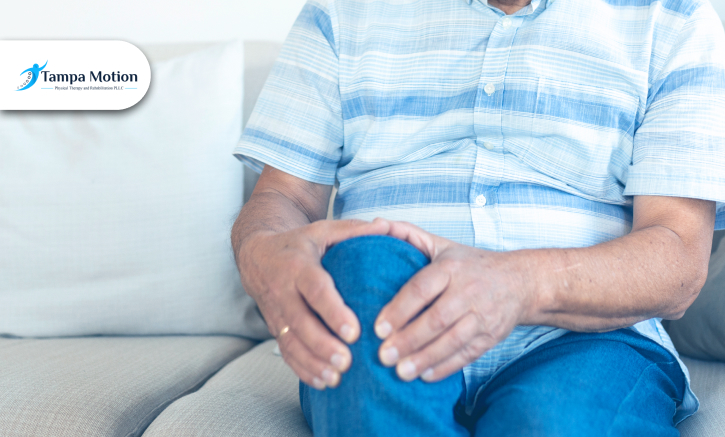
Top 5 Electrical Stimulation Techniques for Joint Pain
Electrical stimulation for joint pain has come a long way from the bulky hospital machines that once hummed behind closed doors. Today, it is a precision tool I use daily at Tampa Motion, guiding patients toward relief without relying solely on medication. As a Doctor of Physical Therapy, I have seen how the right frequency and current can quiet inflammation, retrain tired muscles, and give movement a second chance.
Each pulse tells the body a story, a coded message urging it to heal, to remember, to move again. Some techniques are subtle, others feel almost electric in their results. I have tested them all, refined them through experience, and watched patients walk out lighter, steadier, and smiling.
What happens inside the body when electricity meets pain is more fascinating than most realize, and that is exactly where our journey begins.
1) How Electrical Stimulation Works in Physical Therapy
Electrical stimulation is a versatile therapy I rely on at Tampa Motion to help patients regain comfort, improve mobility, and reduce reliance on medication. Each session is designed to match the joint involved, the intensity of pain, and overall health. The electrical currents affect nerves and muscles in a way that encourages natural pain reduction and improved function (NIH, Physiotherapy Modalities).
Adaptable approach:
By adjusting frequency, intensity, and pulse width, I can target sensory nerves to reduce pain, motor nerves to engage muscles, or both together. For instance, a patient with persistent shoulder discomfort may benefit from higher intensity over surrounding muscles to reduce tension, while someone recovering from knee surgery may receive lower intensity to stimulate movement without aggravating the joint.
Chemical and nervous system effects:
Beyond blocking pain signals, electrical stimulation triggers the release of endorphins, natural chemicals that act as the body’s pain relievers. Many patients report a sense of warmth and comfort during sessions, which encourages gentle movement and early participation in rehabilitation (Journal of Pain Research).
Integration with functional therapy:
I rarely use stimulation alone. When combined with stretching, strengthening exercises, and balance drills, the joint becomes more stable and patients regain confidence in daily activities. For example, after stimulating a knee joint, I guide patients through controlled squats, step-ups, or heel raises, which reinforce strength while minimizing pain. This layered approach ensures progress in both comfort and function.
Having knowledge on these fundamentals sets the stage for exploring TENS, the first technique I typically introduce for immediate, surface-level relief.
2) Technique 1: Transcutaneous Electrical Nerve Stimulation (TENS)
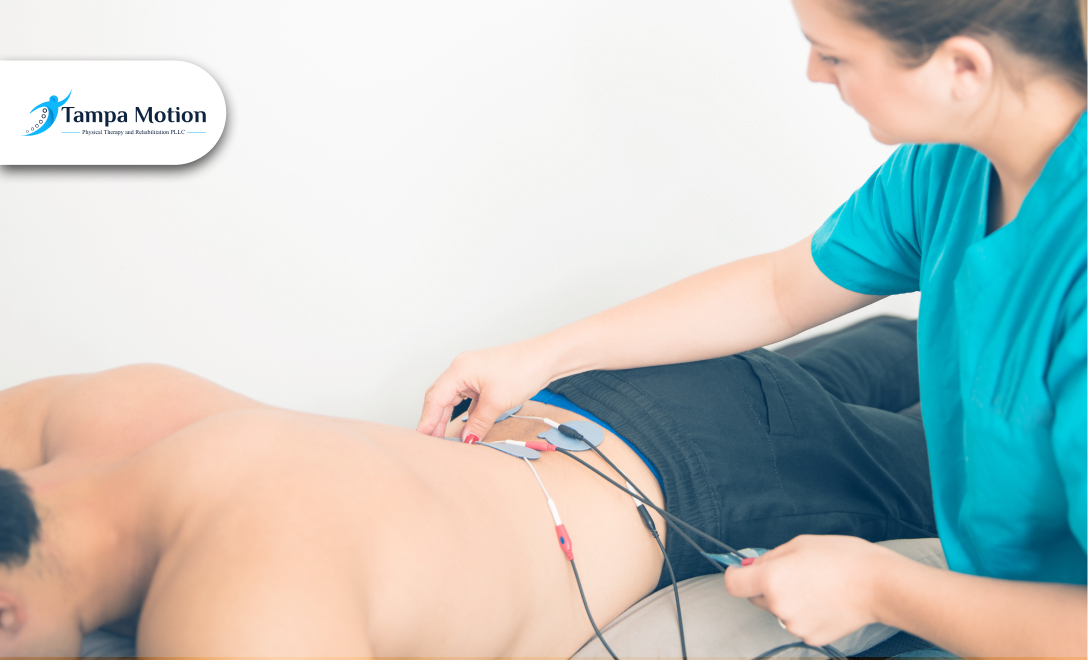
TENS is often the first technique I recommend for mild to moderate joint discomfort. It uses mild electrical pulses to interact with sensory nerves and reduce pain transmission to the brain (Cochrane).
High-frequency relief: High-frequency pulses create a tingling sensation that distracts the nervous system from pain. Patients often notice immediate relief, which allows them to move joints more comfortably during everyday tasks such as walking, typing, or household activities.
Low-frequency, longer-lasting effects: Low-frequency stimulation encourages endorphin production, providing ongoing relief beyond the session. I often recommend combining both high and low frequencies during different times of the day to maintain comfort while performing activities (Journal of Clinical Medicine).
Personalized application: I adjust electrode placement, pulse intensity, and session duration for each patient. Some prefer more noticeable stimulation for faster relief, while others respond best to subtle pulses. Over time, we track the response to fine-tune treatment.
TENS works well for superficial pain, yet deeper joint discomfort often requires Interferential Current Therapy.
3) Technique 2: Interferential Current Therapy
IFC is designed to penetrate deeper tissues such as cartilage, synovial membranes, and surrounding muscles. I often turn to IFC when TENS provides only partial relief.
Reducing tension and stiffness: Intersecting currents create a pulsing effect that relaxes muscles around the joint. Patients often feel immediate loosening, particularly in areas like the shoulder or hip, which helps with range of motion.
Enhancing circulation for repair: The currents stimulate blood flow, delivering oxygen and nutrients to inflamed or stiff tissues. This both speeds healing and decreases swelling, making it easier for patients to move without discomfort.
Improving readiness for exercise: By relaxing muscles and increasing circulation, IFC prepares the joint for strengthening and mobility routines. A patient with knee arthritis, for instance, may perform step-ups and mini-squats more comfortably after an IFC session (CDC).
Comfort and patient experience: The tingling sensation is mild, and many patients find IFC sessions relaxing, sometimes describing the feeling as a gentle massage over the joint.
After preparing the joint with IFC, I introduce Neuromuscular Electrical Stimulation to rebuild muscle support.
4) Technique 3: Neuromuscular Electrical Stimulation (NMES)
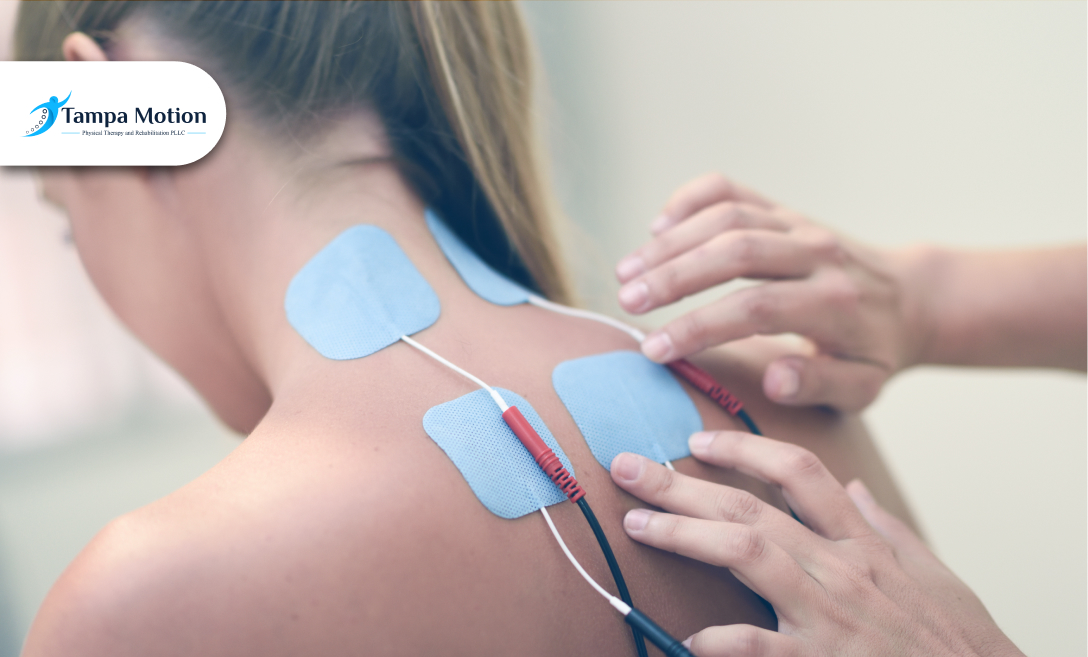
NMES is essential for strengthening muscles around the joint, improving stability, and reducing ongoing discomfort.
Controlled muscle activation: Electrical impulses trigger rhythmic contractions that teach muscles to fire properly. Post-surgery patients often notice improved control when performing everyday movements such as standing up, climbing stairs, or lifting objects.
Support for joint function: Stronger muscles absorb forces that would otherwise stress the joint. For example, a patient with weak quadriceps experiences less knee strain after consistent NMES sessions (Clinical Rehabilitation).
Functional gains in daily life: NMES enhances coordination and movement patterns. I guide patients to pair NMES with voluntary exercises, which helps retrain muscles and improve stability (Physical Therapy Journal).
Session structure: Each session lasts 20–30 minutes, two to three times per week. Over time, patients notice that activities such as walking, reaching, or climbing stairs become easier and less painful.
Once muscles are strengthened, Pulsed Electrical Stimulation can further improve tissue health.
5) Technique 4: Pulsed Electrical Stimulation (PES)
PES is particularly effective for chronic conditions such as osteoarthritis, focusing on tissue repair and joint maintenance.
Cellular stimulation: Pulses activate chondrocytes and connective tissue cells, supporting cartilage repair and improving joint resilience (Osteoarthritis and Cartilage).
Integration with movement: PES works best when combined with mobility and strengthening exercises. This combination encourages gradual improvement in joint function and reduces the likelihood of future discomfort.
Patient comfort: The pulsing sensation is gentle and comfortable, even in sensitive joints. Session duration and intensity are tailored to the individual, allowing the patient to relax during therapy while their tissues receive stimulation.
Long-term support: Regular PES sessions over several weeks can help maintain joint integrity, supporting everyday activities and exercise participation.
For chronic pain that continues despite these methods, Spinal Cord Stimulation addresses pain at the central nervous system level.
6) Technique 5: Spinal Cord Stimulation (SCS)
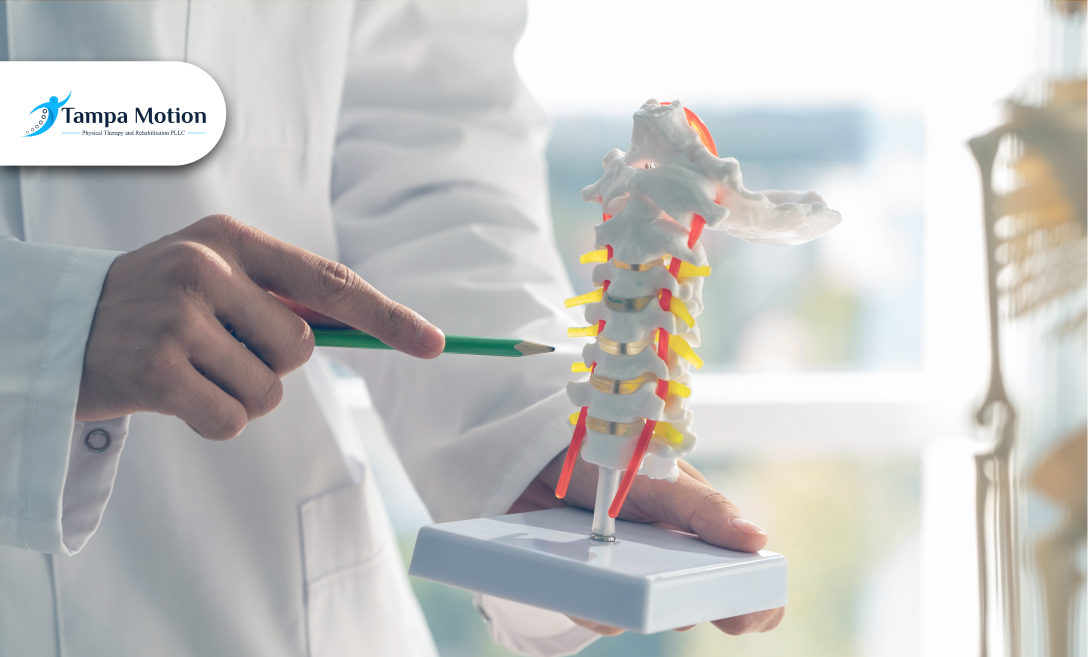
SCS is reserved for persistent joint pain that does not respond to other therapies. The device delivers pulses to the spinal cord, modifying how pain signals are perceived (Cochrane Review).
Placement and control: The device is implanted under the skin, usually in the abdomen or buttocks. Patients can adjust intensity according to comfort and activity levels.
Functional improvements: Many patients regain mobility, reduce reliance on pain medication, and resume previously limited activities (NIH Pain Management Guidelines).
Impact on quality of life: By influencing central pain signals, SCS allows patients to regain independence and participate in daily activities, supporting long-term comfort and movement.
Patient guidance: I educate patients on adjusting stimulation levels during exercise, daily activities, or rest to optimize comfort and maintain joint function.
This approach completes the range of electrical therapies I use at Tampa Motion, showing how layered strategies, from nerves and muscles to tissues and central processing, restore comfort and support function.
Check our latest post to explore more ways to improve overall wellness.
Electrical Stimulation for Joint Pain with Tampa Motion
I use electrical stimulation for joint pain to help patients move with comfort again. Gentle electrical pulses relax tense muscles, calm irritated nerves, and encourage the body’s natural healing rhythm. Each method, from TENS to NMES, is adjusted to match your pain level and joint condition so treatment feels both effective and easy to follow.
This approach helps joints feel stronger and movement feel smoother. I have seen patients regain steady steps, easier stretches, and renewed energy in everyday motion. To begin your own recovery with personalized electrical therapy, contact Tampa Motion and see how small currents can bring big changes.
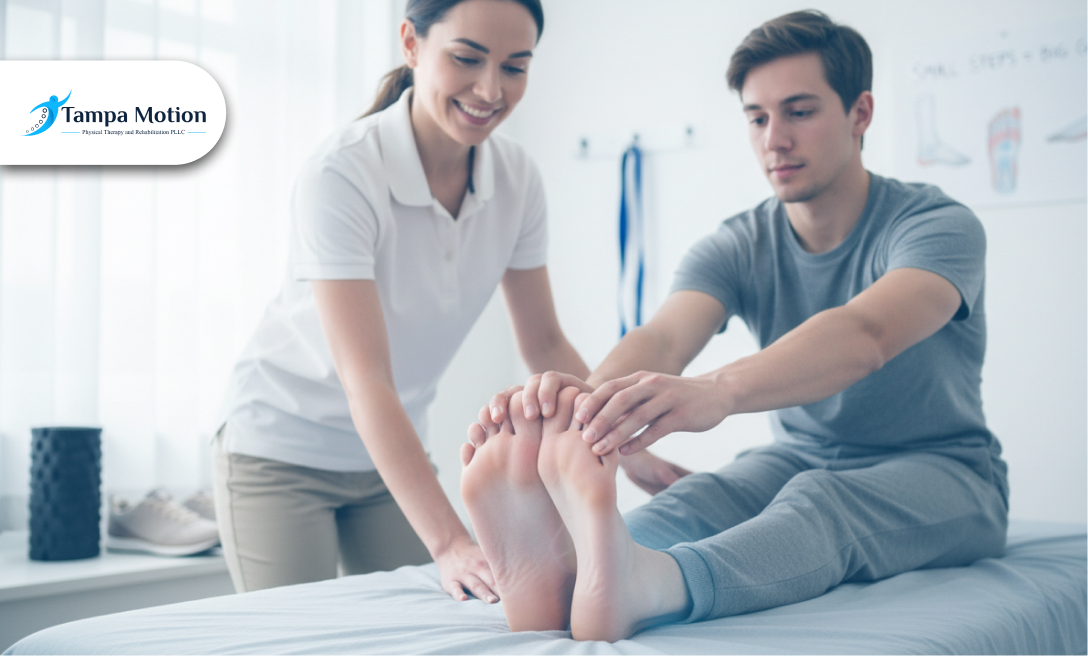
PT Tips for Plantar Fasciitis Relief
PT tips for plantar fasciitis relief often sound simple. Stretch more, rest often, and wear better shoes. Yet anyone who has felt that knife-like heel pain on the first step out of bed knows it is rarely that easy. The ache seeps into your routine, turning morning walks,
workouts, and even grocery runs into quiet negotiations with your own body. As a physiotherapist, I’ve seen how even the smallest adjustments can lead to significant changes. Sometimes it’s about moving smarter.
In the sessions I guide, that’s where recovery begins. Where the root of pain starts to recreate itself. The real shift, though, happens in a moment most people never expect.
1) What’s Really Going On with Plantar Fasciitis
Plantar fasciitis starts quietly, with a bit of heel stiffness that seems harmless. Then one morning, it hits harder, and the pain begins to linger. What’s actually happening isn’t as mysterious as it feels. The plantar fascia, a thick band of tissue running from your heel to your toes, works like a spring every time you walk.
When it’s pushed too far, too often, tiny fibers start to strain, sending that sharp message of protest through your heel. As physiotherapists, we explain it this way. You may think the fascia isn’t broken. However, you may overlook that it’s overloaded. The cause might trace back to long hours on hard floors, worn-out shoes, or tight calf muscles that quietly shift the stress downward.
According to PubMed Central (U.S. National Library of Medicine), over two million people in the United States seek treatment for plantar fasciitis each year, making it one of the most common sources of chronic heel pain. Because this leads to over one million clinical visits per year.
Everything changes when you realize that tension, not damage, is at the heart of it. Because when you stop fighting the pain and start addressing the load, then real recovery begins within, along with physical therapy.
2) Why Physical Therapy Works When Rest Isn’t Enough
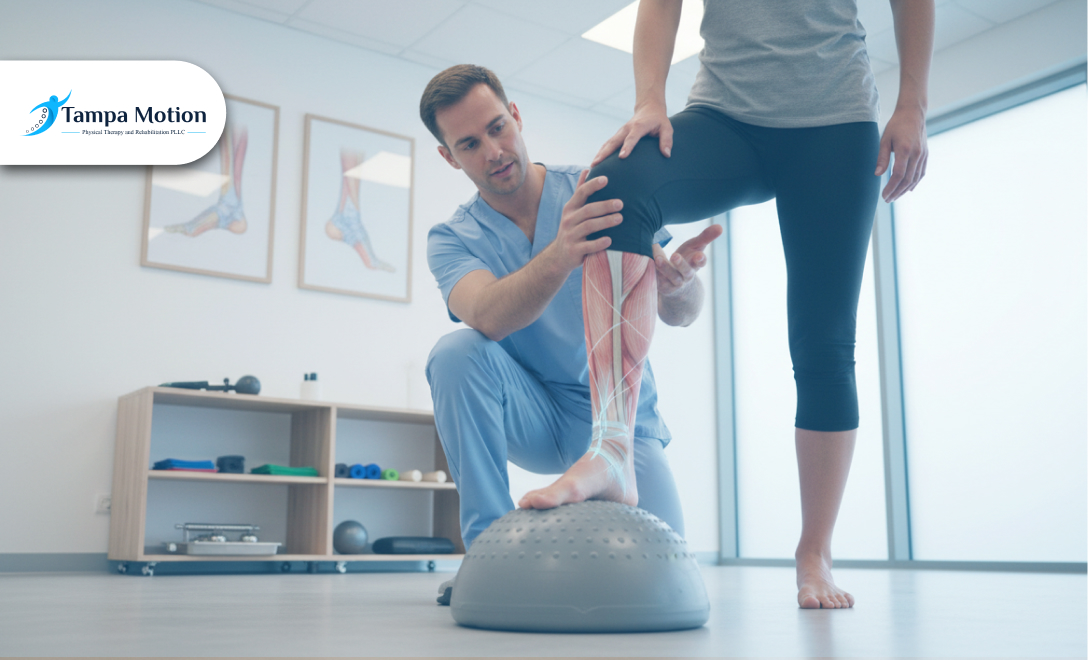
Rest soothes, however, rarely solves. You can’t outwait an overload situation. In my experience, physical therapy for plantar fasciitis becomes the turning point because it addresses why the tissue is irritated, not just that it is.
What drives the pain differs from person to person. Sometimes I find overly tight calves that tug too hard when you walk. Other times, the arch muscles are weak. So the fascia does more work than it should. In some cases both issues coexist. That’s where PT treatment for plantar fasciitis earns its reputation.
We design the rehab plan according to your movement patterns, gait, and biological response. We follow the PT method that works differently on individuals; this is not a general protocol that fits everyone.
Clinical reviews support this approach. A recent systematic review showed that combining stretching, strengthening, and manual therapy reduces pain and improves function better than passive rest alone. Another updated review by the U.S. National Library of Medicine found over 80 percent of patients improve with conservative treatments, of which physical therapy is central.
When we use targeted exercises and movement training, the load on the fascia changes gradually. And that’s how the body begins to shift from resisting to recovering.
3) My Go-To PT Exercises for Plantar Fasciitis Relief
When someone comes in struggling to take those first few morning steps, I don’t start with intensity. I and our team start with control. The best PT exercises for plantar fasciitis work by improving flexibility, strength, and balance in small, consistent doses. Each one resets how your foot absorbs impact.
Calf Stretch Against the Wall
Tight calves are a major trigger. I often use a simple wall stretch, which is one foot forward, one foot back, heels flat, and leaning in slowly. It helps ease the tension that pulls through the heel into the fascia. Most people notice a softer first step after a week of daily practice.
Towel Curls or Marble Pickups
These small movements look almost too easy, yet they build the arch’s natural support. Place a towel flat on the floor, grip it with your toes, and pull it toward you. Or scatter marbles and lift them one by one. This trains the tiny stabilizers that carry your body weight step after step.
Heel Raises
Once pain begins to fade, we shift to strength. Standing on both feet, rise slowly onto your toes, then lower back down with control. This conditions your calves and the fascia to handle load again, reducing future flare-ups.
Plantar Fascia Roll
Rolling a frozen water bottle or firm ball under the arch can loosen tight tissue and promote circulation. I often recommend it before getting out of bed or after long hours on your feet and it keeps stiffness from setting in.
These exercises are simple; however, their consistency builds momentum. The most important part is often ignored. That is doing it properly. Because stretching your body wrong or on your own can affect you in a more negative way.
Over time, professional physiotherapists like us teach the foot to move the way it was designed to. Strong, flexible, and pain-free. The next step is knowing how to support that progress beyond the clinic.
4) Daily Habits That Speed Up Recovery
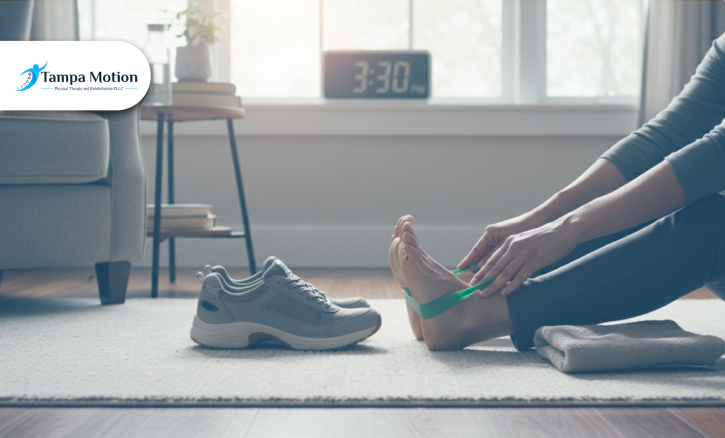
Healing the fascia isn’t just what happens inside a clinic session. When you practice consistently from dawn to dusk, that really shifts momentum. Below are evidence-grounded, real-world habits I share with my patients.
(I) Footwear Matters and Choose Wisely
Your shoes are silent partners in this process. A study found that 83 percent of people with plantar fasciitis wore inappropriate footwear. Thin soles, low heels, and no arch support while their heel pain was more severe.
What I tell people is to pick shoes with a moderate heel height (0.5–4 cm), cushioned insoles, and firm arch support. Rotate shoes so none wears out too fast. Avoid walking barefoot on hard surfaces, especially in early mornings.
(II) Lean Into Load Management
It can be tempting to ‘push through’ pain, especially when life demands it. However, chronic overload is part of how you got here. I coach patients to stagger long-standing or walking tasks, add seated breaks, and plan their movement in blocks rather than bursts. In short: break up the stress.
(III) Activate the Small Helpers Under Your Foot
Beyond the big muscles, the intrinsic foot muscles (those tiny ones inside the arch) help stabilize and absorb shock. Recent consensus programs propose progressive strengthening of the foot and ankle musculature as part of plantar heel pain rehabilitation.
To incorporate this:
Use toe-spreading, towel scrunches, or “short foot” activation multiple times per day.
As pain allows, start light resistance work on those muscles, matching load to recovery.
Monitor fatigue If foot soreness spikes the next day, dial back.
(IV) Know When It’s Time for Further Assessment
Most cases resolve with consistent conservative work. Most people … recover in several months with conservative treatment (stretching, modifying activity, and proper footwear).
If these habits aren’t helping after 6 to 8 weeks, or pain worsens, it may be time for imaging or specialist referral. Persistent heel pain or pain at rest may signal complicating issues like partial tears or nerve irritation, as per the American Academy of Family Physicians.
5) When It’s Time to Get a PT Assessment
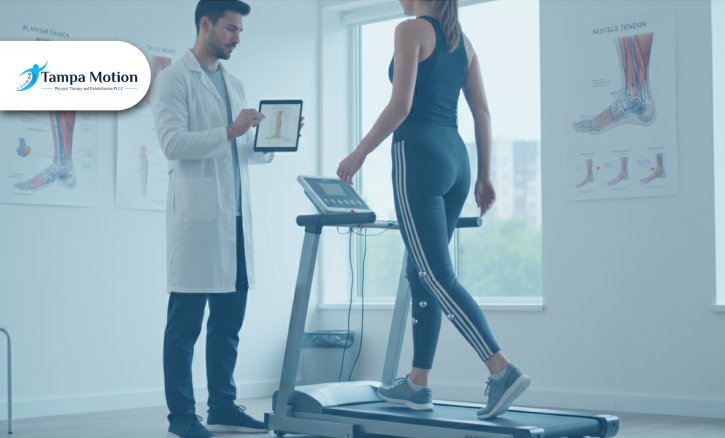
Sometimes heel pain eases with rest, stretching, and small lifestyle fixes. Sometimes it doesn’t. When the discomfort keeps slipping back or spreads beyond the heel, that’s the body’s cue for a closer look. A physiotherapy assessment is about tracing the movement patterns that keep the fascia under stress.
During a full evaluation, I study how the foot lands, how the ankle tracks, and how the hips move above it. Gait analysis often reveals what self-care can do. Uneven loading, muscle imbalances, or a lack of stability that subtly fuels the problem.
According to a review in Frontiers in Sports and Active Living, incorporating gait correction and targeted strengthening shortens recovery time and lowers recurrence rates in plantar fasciitis patients.
If pain lingers beyond six to eight weeks despite consistent home care, or if swelling, numbness, or sharp night pain appears, it’s time for professional guidance. Early intervention helps identify complications like nerve entrapment or heel spurs before they harden into chronic issues.
A proper PT plan doesn’t just calm inflammation, however; it rebuilds tolerance. Once we map how your foot moves and what triggers stress, we can retrain those mechanics. That’s where steady progress begins and where lasting relief stops being guesswork. The final step is learning how to hold on to that progress long-term.
Keeping Your Feet Pain-Free for the Long Run
Plantar fasciitis doesn’t have to define your mornings. With consistent mobility work, gradual load management, and the right strength training, your feet can return to doing what they were built for, to move freely. Long-term recovery is about rebuilding trust in every step.
That’s exactly what we help you do. Our programs focus on restoring natural movement patterns, improving flexibility, and keeping pain from coming back. We want every patient to walk out stronger, steadier, and ready for the long run.
If you’re ready to stop managing pain and start reclaiming comfort, schedule your personalized session today through Tampa Motion’s contact page. Your feet deserve lasting relief, and we’re here to help you take that next step with confidence.
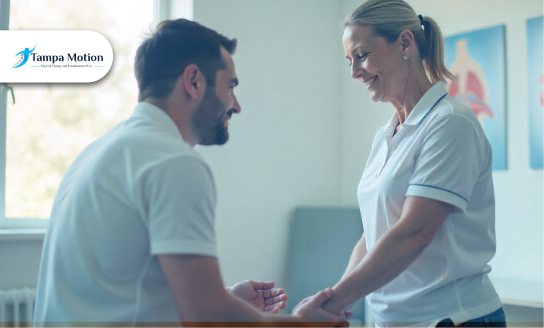
When to See a PT for Inner-Ear Imbalance
Most people brush off dizziness as nothing more than standing up too quickly or skipping a meal. It feels minor, fleeting, and hardly worth a second thought. However, when that unsteady feeling lingers, balance issues can quietly interfere with everyday life, from walking across a room to driving a car.
What may feel like a minor wobble could actually signal a deeper problem in your balance system, and understanding what’s happening inside your inner ear is the first step. And the real question is whether you would recognize the moment it is time to seek help.
1) What Inner-Ear Imbalance Really Means
The vestibular system, located in the inner ear, helps you maintain balance, orient yourself in space, and stabilize vision during movement. When this system is disrupted by infection, trauma, or other causes, you may feel dizzy or unsteady, or have vertigo, or experience blurred vision during motion.
According to the National Institute on Deafness and Other Communication Disorders (NIDCD), vestibular disorders can result in symptoms such as imbalance, vertigo (illusion of motion), disorientation, visual blurring during motion, and falling.
Older adults are particularly at risk: balance problems increase with age due to physiological changes, medications, and comorbidities. The National Institute on Aging notes that many older adults experience dizziness or balance issues, which may stem from certain medications, vestibular disorders, or other medical conditions.
2) Clear Signs You Should See a Physical Therapist
Here are warning signs indicating it’s time to consult a PT for inner-ear imbalance:
Persistent or frequent dizziness or vertigo
If episodes last more than a few minutes, recur often, or are triggered by movement, head turning, or position changes, these suggest vestibular dysfunction.Repeated falls or unsteadiness
Falling or losing balance, especially when walking, moving in dim light, or turning quickly, is a red flag. The Centers for Disease Control and Prevention reports that 1 in 4 older adults (65+) fall each year, many due to balance and mobility issues.Blurred or unstable vision while moving
Commonly known as “oscillopsia,” this symptom makes objects seem to bounce when you walk or move your head. This is another sign that your vestibular and visual systems aren’t coordinating properly.Symptoms worsened by specific positions
Actions such as lying flat, turning in bed, looking up, and bending forward. If these provoke dizziness, it could point to benign paroxysmal positional vertigo (BPPV), which is treatable with repositioning exercises. Research shows that such steps create a positive impact among standard treatments for BPPV.Imbalance after infection, illness, or head injury
When symptoms do not resolve naturally following an infection (such as vestibular neuritis), concussion, or inner-ear issue, PT can aid recovery via vestibular rehabilitation.Interference with everyday life or avoidance of activities
If you avoid driving, walking in crowded or unfamiliar places, exercising, or social settings because of fear of dizziness or falling, PT can provide strategies to restore confidence and function.
3) What a Physical Therapist Can Do for You
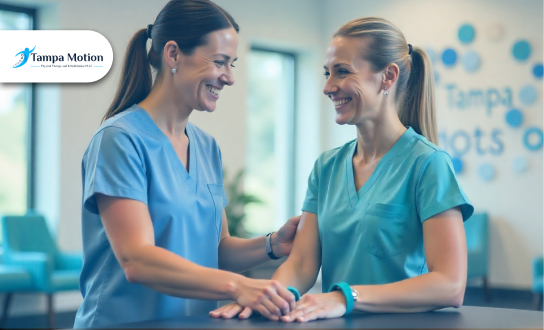
When balance issues start interfering with daily life, a physical therapist can provide you with a sense of relief. At Tampa Motion, our approach is both personalized and compassionate, designed to help patients regain stability and confidence rather than just manage symptoms.
Targeted Vestibular Rehabilitation
Through vestibular rehabilitation therapy (VRT), our therapists guide patients with exercises that retrain the inner ear and brain to work together. These sessions are customized to each person’s symptoms, making recovery more effective and less frustrating.
Precise Repositioning for BPPV
For those experiencing sudden vertigo triggered by movement, specific maneuvers can reposition tiny inner-ear crystals causing the dizziness. Tampa Motion’s PTs perform these physical tasks with care, ensuring both safety and relief.
Balance and Fall Prevention Training
Even mild imbalance increases the risk of falls, which can have serious consequences. Tampa Motion teaches practical strategies to strengthen stability, adapt daily routines, and move confidently at home or outside.
Improving Visual and Motion Coordination
When dizziness disrupts vision or motion perception, PT (physical therapist)-led exercises enhance gaze stability and tolerance to movement. We support patients step by step, helping them feel steady and capable again.
With the right guidance, what once felt like a limiting, unpredictable symptom can become manageable, allowing patients to reclaim independence and confidence in their daily lives.
5) When to Seek Emergency Medical Care Instead
Dizziness alone isn't always a cause for alarm. However, certain symptoms may indicate a serious medical condition that requires immediate attention. If you experience a sudden severe headache, slurred speech, double vision, weakness, or difficulty walking, it's crucial to seek emergency medical care promptly.
These symptoms could be indicative of a stroke or other neurological conditions, which necessitate urgent intervention. According to the Centers for Disease Control and Prevention (CDC), sudden trouble walking, dizziness, loss of balance, or lack of coordination are signs of a stroke. If you or someone else exhibits these symptoms, call 9-1-1 immediately. Time is critical in stroke treatment, and early intervention can significantly improve outcomes.
It's important to remember that physical therapists are equipped to diagnose or treat acute medical emergencies like strokes. However, therapists can reduce the likelihood of such situations by initiating treatment early on. If you suspect a stroke, do not wait to see if symptoms improve. Call emergency services right away.
Once immediate medical concerns are addressed, and if balance issues persist, a physical therapist can play a vital role in rehabilitation. They can assess and treat underlying conditions contributing to balance problems, helping you regain stability and confidence in your daily activities.
6) How Tampa Motion Supports Your Journey to Balance
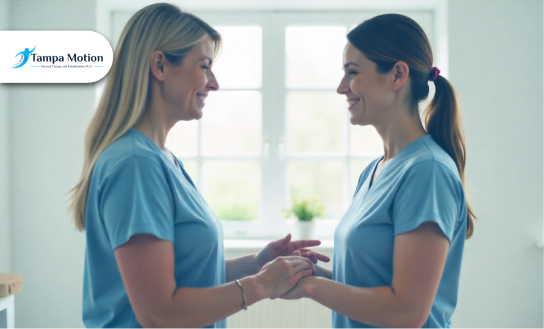
We understand that balance issues can disrupt daily life. Our personalized approach to vestibular rehabilitation therapy (VRT) is designed to address the unique needs of each patient, helping them regain stability and confidence.
Comprehensive Vestibular Assessment
Our experienced physical therapists conduct thorough evaluations to identify the specific causes of dizziness and imbalance. This includes assessing inner ear function, coordination, and strength to develop a tailored treatment plan.
Targeted Rehabilitation Exercises
Based on the assessment, we implement specialized exercises aimed at improving gaze stability, enhancing balance, and reducing dizziness. These exercises are designed to retrain the brain and vestibular system to work together more effectively.
Education and Fall Prevention Strategies
We educate patients on lifestyle modifications and safety measures to prevent falls. This includes guidance on home environment adjustments and techniques to improve posture and movement patterns.
Ongoing Support and Monitoring
Our team provides continuous support throughout the rehabilitation process, adjusting treatment plans as needed to ensure optimal progress and outcomes.
Frequently Asked Questions About Inner-Ear Imbalance
1) Can inner-ear imbalance resolve on its own?
Sometimes mild dizziness or imbalance improves without intervention, especially if caused by dehydration or temporary ear congestion. However, persistent or recurring symptoms may indicate a vestibular disorder.
2) How long does vestibular rehabilitation therapy take?
The duration depends on the severity and type of imbalance. Many patients notice improvement within 4–6 weeks, while others may need longer programs personalized to their symptoms and progress.
3) Are there exercises I can do at home safely?
Yes, PTs often provide home exercises to complement in-clinic therapy. These may include simple balance drills, gaze stabilization movements, and gentle walking routines. Tampa Motion ensures patients know which exercises are safe and effective for their specific condition.
8) Tips for Maintaining Long-Term Balance and Preventing Recurrences
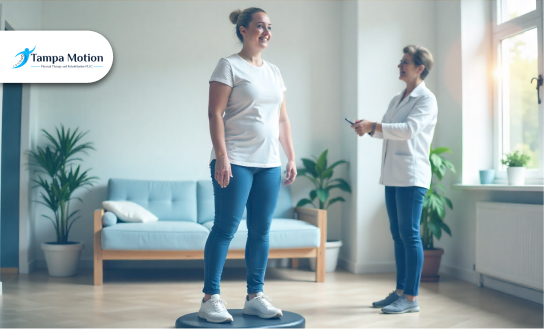
Recovering from inner-ear imbalance is only part of the journey. Maintaining stability and preventing future episodes requires consistent attention to daily habits and proactive care.
Keep Your Body Moving
Regular low-impact exercise, such as walking, swimming, or gentle yoga, strengthens muscles, improves coordination, and supports balance. According to the National Institute on Aging, consistent physical activity reduces fall risk in older adults.
Practice Balance and Gaze Exercises
Simple home exercises recommended by PTs, including single-leg stands, heel-to-toe walking, and gaze stabilization movements, reinforce the vestibular system and improve visual coordination. Tampa Motion provides personalized routines to safely integrate these exercises into daily life.
Optimize Your Environment
Reduce hazards at home by keeping walkways clear, adding non-slip mats in bathrooms, and ensuring adequate lighting. Home modifications are a major step in preventing falls.
Stay Hydrated and Monitor Health
Dehydration, certain medications, and untreated medical conditions can worsen balance issues. Regular hydration, routine health checkups, and medication reviews with your healthcare provider support long-term stability.
Schedule Periodic Check-Ins
Even after symptoms improve, follow-up evaluations with a physical therapist can catch early signs of imbalance and adjust exercises as needed, keeping your balance sharp and reducing future risk.
Regain Your Confidence and Take the Next Step
Balance issues don’t have to control your daily life. At Tampa Motion, our team is ready to guide you toward steadier movement, safer steps, and renewed confidence. Whether you’ve noticed frequent dizziness, unsteadiness, or just want to prevent future problems, reaching out is the first step toward reclaiming control.
Make an appointment today. Fill out the contact form with your name, email, phone number, and a brief description of what you’re experiencing. Our team will respond promptly to schedule your consultation and answer any questions. Call us at +1 813-291-3536 to schedule a consultation.
You can email athena.akram@tampamotion.com or visit us at 8333 Gunn Highway, Tampa, FL 33626. Get in touch now and start your journey to recovery.
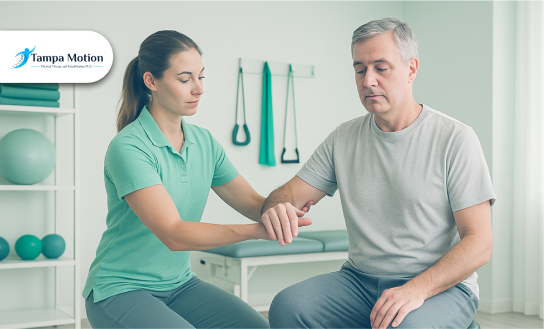
Physical Therapy for Vertigo: What Works
Nearly 40 percent of U.S. adults will experience vertigo at some point in their lives, according to the National Institutes of Health. A figure that shows how common and how disruptive it can be. In Tampa, where life moves in motion. Your sickness can turn the vibrant rhythm of your life into sudden, unsettling chaos. One step becomes cautious, one turn unbalanced, and even familiar motions feel uncertain.
For many locals, vertigo is a barrier to work, weekend plans, and the simple pleasure of moving without fear. However, what if the key to recovery lies not in pills or scans, rather in retraining the body’s own sense of balance? The answer may surprise you.
1) Vertigo, More Common Than You Think
Vertigo isn’t a rare quirk and is surprisingly widespread. It’s a sensation of your world spinning even when you’re perfectly still, often paired with nausea or unsteadiness. It’s disorienting and deeply unpleasant, and that kind of imbalance can hit hard.
Roughly 20 to 40 percent of adults will experience dizziness or vertigo at some point in their lives. In any given year, about 5 percent of people contend with vertigo, and incidence increases as one gets older, particularly after forty, according to Medscape.
More striking still, more than 20 percent of adults report dizziness or imbalance annually, and as many as 40 percent of those over 40 face it. These aren’t statistics, they’re reminders that vertigo quietly interrupts the lives of many around us.
Unfortunately, vertigo doesn’t keep a calendar. At Tampa Motion, therapists see cases year-round. Many follow boating mishaps, weekend sports injuries, or seasonal sinus flare-ups that trigger inner-ear imbalance. When humidity rises and allergy season arrives, even harmless pollen can throw the seaside jogger off balance.
2) The Science Behind Physical Therapy for Vertigo
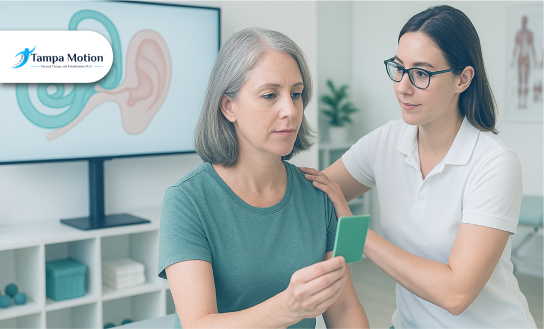
When your head tilts, turns, or accelerates, hidden miracles happen inside your ear. Your vestibular system senses rotation and motion and sends that data straight to your brain. There, it partners with your eyes and muscles to align sight and movement, keeping you upright in a fast-moving life.
However, when that system falters, everyday actions like mounting a paddleboard or turning in traffic can feel unsteady. That’s where physical therapy steps in, transforming disorientation into dynamic recovery.
First up is the Epley maneuver, a deft repositioning treatment. According to the National Institute of Health (NIH), more than 1 in 20 (nearly 3.3 million) children between the ages of 3 and 17 have a dizziness or balance problem in U.S. children.
And as per numerous studies and systematic reviews published on the National Library of Medicine's database (PubMed), the Epley maneuver is recognized as a safe and highly effective treatment for benign paroxysmal positional vertigo (BPPV).
In most cases, one treatment resolves symptoms for 80–90 percent of patients, and a second brings relief to nearly all.
Then comes Vestibular Rehabilitation Therapy (VRT), a suite of exercises that pushes your body’s natural adaptation mechanisms. By repeating specific eye, head, and body movements, your brain learns to recalibrate and compensate. Studies show VRT significantly reduces dizziness, lowers fall risk, and improves balance even for patients with persistent vestibular deficits.
Gaze stabilization exercises are another key. Executed under expert guidance, these help your eyes lock on a target while your head moves—retraining the brain’s coordination so you’re not thrown off when you're walking on a crowded Tampa trail or riding a wave at sunset.
Finally, the real world comes into the training room through balance simulations by standing on foam, closing your eyes, or balancing on unpredictability. They force your brain to rely on vision, touch, and proprioception in new ways, building resilient balance skills that stick.
What unites these treatments is a vital truth. We are not hiding the vertigo’s condition; we retrain your brain and body, which promotes long-term balance. You’re getting relief as well as learning to trust your world again. That trust and confidence matter.
3) Tampa Motion’s Proven Approach
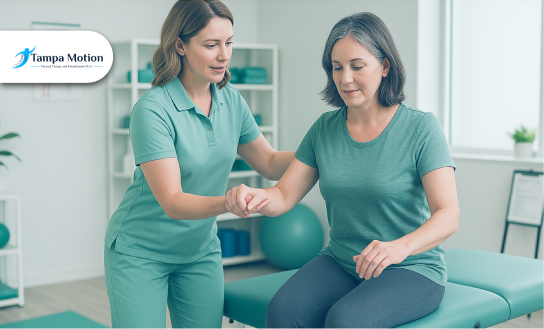
In a city built on movement, Tampa Motion has earned its reputation as the place locals turn to when vertigo threatens to derail their lives. Their formula blends clinical precision with human warmth, creating treatment plans that feel as individual as the people they serve.
Tampa Motion stands out because of :
Specialized Training: All therapists are highly skilled in vestibular rehabilitation, using the latest research and proven protocols.
Track Record of Results: Hundreds of Tampa patients have returned to activities they once thought were out of reach.
Personalized Care: Every plan is custom-built, considering lifestyle, goals, and unique health needs.
Our Treatment That Fits Real Life:
In-office sessions for guided progress and real-time adjustments.
At-home exercises suitable for everyday routines, from quick balance checks in the kitchen to eye-head coordination drills before a morning walk.
Flexible programs that adapt as symptoms improve, ensuring gains are permanent.
The result is more than symptom relief. It’s a full return to your active lifestyle. Our treatment plan is grounded in science and built for long-term confidence.
Next, we’ll look at the lifestyle strategies that make these results last, no matter the season or setting.
4) Our Support About Lifestyle for Lasting Results
Staying balanced goes beyond therapy. Tampa Motion builds long-term steadiness by blending personalized care with smart, lifestyle-savvy coaching.
(I) Tips that actually make a difference:
Stay Hydrated in the Heat: Dehydration can worsen vertigo, and in the humid Florida climate, it’s a hidden risk. Even mild dehydration can contribute to vestibular imbalances, making proper fluid intake essential for maintaining equilibrium.
Manage Allergy Season and Sinus Health: Pollen and seasonal allergies can inflame the sinuses and disrupt ear pressure, triggering vertigo. Tampa Motion encourages sinus hygiene with saline rinses, nasal sprays, and allergen avoidance.
Practice Safe Boating and Water Sports Habits: It’s important to prevent motion-related triggers. Experts recommend staying hydrated, avoiding alcohol, choosing mid-ship positions on boats, and keeping your gaze on the horizon to reduce sensory conflict.
(II) How Tampa Motion weaves these habits into recovery:
Therapists coach patients on daily rituals. From balancing hydration levels to choosing activities during high-pollen days to reduce flare-ups outside the clinic.
Personalized “vertigo-first” routines ensure that whether heading out for a morning paddle or navigating Ybor City, you move with more confidence and less risk.
Insightful reminders like carrying a water bottle, checking pollen counts, or scanning for sinus-friendly meals can turn good intentions into habits.
With this lifestyle foundation, relief continues after the appointment. It is present throughout your active days and vibrant nights.
Next, we’ll explore why early intervention is more than helpful. It’s essential to avoid a spiral of falls, fear, and missed opportunities.
5) Why Early Intervention Matters
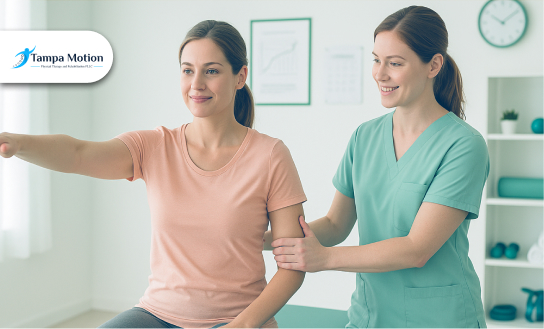
Ignoring recurring vertigo can be dangerous. When dizziness becomes a regular companion, the risks escalate quickly.
Increased Fall Risk: Vertigo can cause disorientation, leading to falls. In older adults, falls are a leading cause of injury and death.
Loss of Independence: Fear of falling often leads to reduced activity, which can result in muscle weakness and further balance issues.
Prolonged Discomfort: Without treatment, vertigo can persist, affecting daily life and mental health.
Early physical therapy, particularly Vestibular Rehabilitation Therapy (VRT), offers significant benefits:
Shorter Recovery Time: Starting therapy early can reduce the duration of symptoms and improve outcomes.
Habituate the brain: Vertigo is often triggered by certain movements. VRT includes controlled, repeated exposure to these movements, which gradually desensitizes your brain and reduces the intensity of the dizzy spells.
Improved Quality of Life: VRT can alleviate dizziness, enhance balance, and reduce the risk of falls.
Reduces dizziness and enhances balance: The exercises in VRT are designed to improve your gaze stabilization. That means the ability to keep your eyes focused on a target while your head is moving and also postural control (the ability to maintain your balance). These skills are essential for daily activities like walking, reading, and driving.
Reduces the risk of falls: With improved balance and stability, you can navigate your environment more confidently and with less risk of falling, which is a major concern for people with chronic dizziness. This can be especially life-changing for older adults.
Breaks the cycle of anxiety and avoidance: Many people with vertigo develop anxiety and a fear of falling or triggering a dizzy spell. This leads to them avoiding social outings, exercise, and other activities they once enjoyed.
VRT helps you regain control over your body, which in turn rebuilds your confidence and reduces this cycle of avoidance.
6) Take the First Step Toward Lasting Vertigo Relief in Tampa
Living with vertigo can feel isolating and frustrating. Where an active lifestyle is cherished, seeking early treatment at Tampa Motion can help you regain your balance and confidence. This is ensuring you continue to enjoy everything. If you have any questions or concerns, don’t hesitate to reach out. Let’s talk directly at +1 813-291-3536 or email athena.akram@tampamotion.com for timely, friendly answers.
For your convenience. Tampa Motion is located at 8333 Gunn Highway, Tampa, FL 33626, easy to access from anywhere in the area. Do you prefer online? Fill out our simple contact form on tampamotion.com/contact, and our team will get back to you as soon as possible to schedule your personalized assessment.
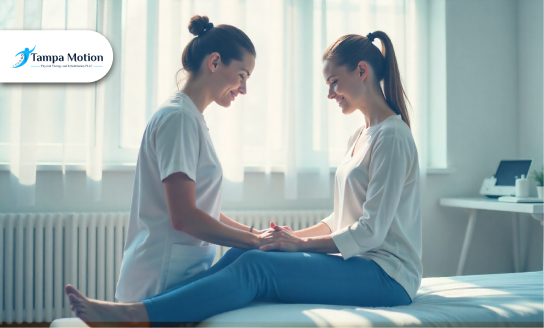
Coping with Urinary Incontinence? PT Methods That Work
The humidity clings to your skin as you jog along Tampa’s Bayshore Boulevard. Pelicans dive for fish, paddleboarders drift past, and the sun hits that golden angle over the water. Then it happens, a sudden loss of control. It is not the kind of story you bring up over dinner, yet millions of Floridians live it every day.
Urinary incontinence is more than a medical condition, it is a daily disruption that can shrink your social life and limit the activities you love. While ads push medications and surgeries, a quieter revolution is happening in physical therapy clinics across Florida. This approach blends science, technology, and personalized training to retrain your body’s control system.
Tampa Motion is right in the middle of it, and the way they get results might not be what you expect.
I) The Quiet Epidemic Nobody Talks About
Across the United States, urinary incontinence affects more than 25 million adults. In Florida, the number skews higher due to a large population of older residents and an active lifestyle that keeps people moving well into their later years. Warm weather draws people outdoors year-round, from morning beach runs in Clearwater to long afternoons paddleboarding on the Gulf.
For anyone living with bladder control issues, these moments are shadowed by constant calculation, where the nearest restroom is and how far they can push themselves without an accident.
The stigma runs deep. Many people delay speaking to a professional for years, assuming it is a normal part of aging or something they must manage alone. That silence comes at a cost, reducing social engagement and cutting into physical activity, two things that are central to life in Florida.
This is where a different kind of care steps in, one that approaches bladder control as a skill that can be rebuilt rather than a problem to hide.
II) Why Physical Therapy Wins Over Pills
Medications can mask symptoms for a while, and surgery can alter anatomy, yet neither addresses the underlying muscle and nerve coordination that keeps the bladder working smoothly. Physical therapy takes a different route, focusing on restoring the body’s natural control system. The science is simple and precise, training the pelvic floor and core muscles to respond automatically, just as they once did.
Across Florida, more people are trading in prescription refills for therapy sessions. They are finding that a few months of targeted exercises, guided by a specialist, can produce long-term change without the side effects of medication. A Clearwater retiree who had stopped golfing now plays weekly without fear. A young Tampa mother who once avoided long car rides now makes the drive to Miami with confidence.
These results are not the product of guesswork. They come from a methodical process that blends muscle re-education with technology, a combination that forms the foundation for the next stage of recovery.
III) Pelvic Floor Training, Florida-Style
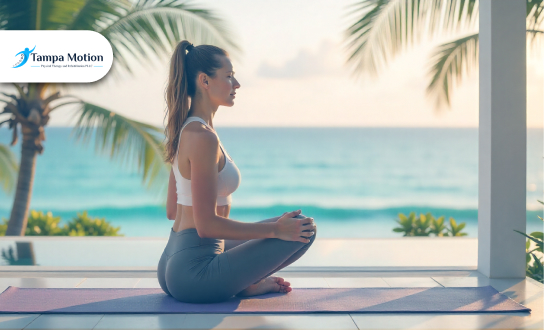
Think of the pelvic floor as your body’s command center for bladder control, a network of muscles and connective tissue acting like a security gate. When that system weakens or loses coordination, the gate slips, and control becomes unreliable. Physical therapy switches the system back online, retraining it to respond with speed and precision.
At Tampa Motion, this process is both science-driven and deeply practical:
Targeted activation drills that teach the muscles to contract and relax on command.
Core integration works combining posture, breathing, and movement so the pelvic floor reacts instinctively during daily activity.
Progressive challenge routines that shift from static exercises to functional, real-world movements like bending, lifting, and running.
To accelerate results, therapists use biofeedback technology that turns invisible muscle activity into visible data. Patients see their muscle engagement, strength levels, and endurance displayed in real time. That instant feedback sharpens awareness and speeds muscle memory formation.
For background on this approach, the National Institutes of Health offers in-depth research on biofeedback for incontinence.
It is the intersection of biology, movement, and technology, and it sets the stage for even more advanced tools in modern physical therapy.
V) Lifestyle Tweaks That Florida Life Demands
In Florida, the outdoors is not a season, it is a year-round state of mind. Mornings start with paddleboards slicing through glassy water, afternoons stretch across sun-bleached fairways, and weekends revolve around sails, surf, and open skies.
Yet, that same open-air lifestyle presents challenges for anyone managing urinary incontinence. Heat accelerates fluid loss, humidity magnifies fatigue, and activity schedules rarely sync with the body’s ideal rhythm.
Tampa Motion’s approach adapts therapy to fit these realities, ensuring that progress is protected while patients continue to enjoy the activities they love.
Major strategies include
Smart hydration timing: Front-load fluids before high-activity windows and taper intake before events where restroom access is limited.
Sport-specific adjustments: Golfers learn to structure play for comfort and control, while runners plan pacing and routes with restroom options included.
Beach and boat modifications: For long stretches on the water, therapy accounts for balance, posture, and core engagement to reduce pelvic floor strain.
Climate-aware recovery: Post-activity cooldowns and electrolyte routines counteract Florida’s heat without slowing progress.
These strategies are tested in real-world Florida conditions so whether patients are steering a sailboat into open water or jogging the bayside trail, the plan becomes second nature. The result is more than symptom management, it is the return of freedom and spontaneity.
The next step focuses on the mental dimension, where confidence and control meet to make these physical gains permanent.
VI) Mind Over Matter for Bladder Control
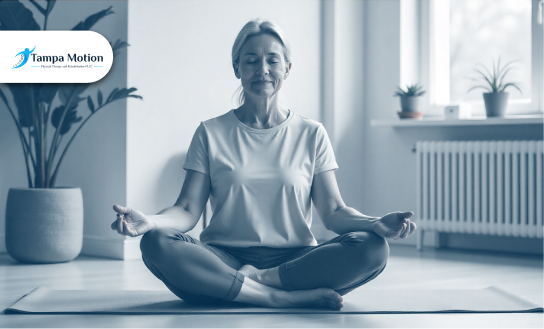
Muscle training is only half the equation. The brain controls bladder function through a constant stream of signals, and those signals are heavily influenced by stress, habit, and emotion. Tampa Motion incorporates mental conditioning to help patients reset that control system.
Stress incontinence often appears during high-impact or high-pressure moments, which are common in Florida’s active sports culture. Tennis serves, beach volleyball spikes, even a sudden burst of laughter during a paddleboarding trip can trigger leakage if the mind and body are not working in sync.
Therapists use techniques that calm the nervous system and improve coordination:
Breathing drills that anchor the pelvic floor during sudden movement.
Mindfulness apps that guide daily practice in body awareness and relaxation.
Visualization exercises that retrain the brain to anticipate and control bladder responses before stress hits.
These tools help replace anxiety with confidence, allowing physical gains to translate into everyday life. The next phase is turning that confidence into a personalized roadmap for long-term success.
For more on the mental connection to bladder control, the National Association for Continence provides valuable resources.
VII) Your Tampa Motion Roadmap
Your first appointment is less about treatment and more about reconnaissance. Tampa Motion treats it like a high-resolution scan of your body’s performance system. Sensors and trained hands pick up details you cannot see, from micro-delays in muscle response to posture shifts that hint at deeper imbalances. The aim is to chart not just what is wrong, but how your body moves, reacts, and compensates in real time.
From there, therapy becomes a living blueprint. Instead of a rigid set of exercises, the program reshapes itself with you. Strength gains trigger new challenges, coordination wins open the door to more complex movements. A grandmother training to lift her grandchild moves along a different track than a triathlete prepping for an open-water swim, yet both end up reclaiming the confidence to move without fear.
Milestones are marked in 2 ways, numbers that quantify muscle endurance and coordination, and moments that change your life, like playing 18 holes without scanning for the nearest restroom. You leave each session knowing what has improved and exactly where the next breakthrough lies.
By the time most people finish their roadmap, they are not just stronger, they have rewired how their body responds under pressure. Early intervention locks in those gains before habits and weakness take root, turning short-term progress into a long-term upgrade to how you live and move.
The Bottom Line for Floridians
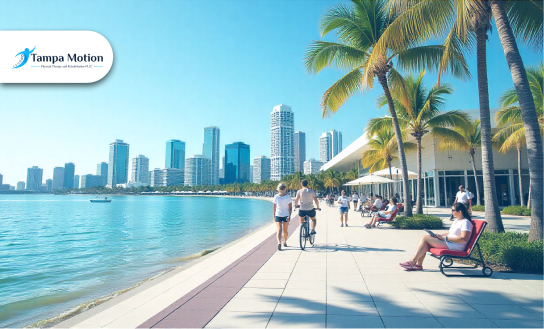
Waiting only lets symptoms take hold. Early intervention through physical therapy offers the fastest route to reclaiming control, often preventing the need for invasive procedures. In Florida’s active and vibrant communities, that difference means more days spent doing what you love without hesitation or fear.
Physical therapy is both a treatment and a proactive choice that can reshape your future. Tampa Motion stands ready to guide you through every step, customizing care that fits your unique needs and lifestyle.
You do not have to live with incontinence. Reach out to Tampa Motion today and take the first step toward freedom.
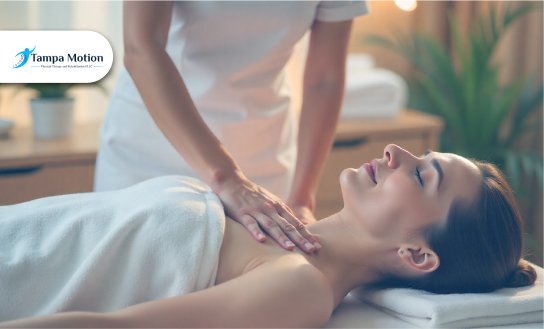
What is Manual Lymphatic Drainage & Who Needs It?
The room is still except for the rhythmic sweep of practiced hands, tracing deliberate paths across the skin. The movements are light, almost imperceptible, yet each one follows a map invisible to the eye. This is manual lymphatic drainage, a therapy that has been quietly changing the way people heal and recover. It does not work by force, it coaxes one of the body’s most overlooked systems into motion.
Patients come seeking relief from swelling, faster recovery after surgery, or a renewed sense of vitality. What happens next, as the body responds to this gentle ritual, is both deeply physiological and surprisingly transformative. The question is, why does such a subtle touch have such profound effects?
1) What Exactly Is Manual Lymphatic Drainage?
Manual lymphatic drainage began as a careful observation, and a method, developed in the 1930s by Emil and Estrid Vodder while they studied swollen lymph nodes on the French Riviera, then taught the technique across Europe as lymphology gained shape.
MLD is intentional and spare, not forceful. Therapists use light, rhythmic, skin-stretching strokes that follow the superficial lymphatic pathways. Each motion is designed to coax pooled fluid toward functioning nodes so it can be cleared.
Unlike traditional massage that targets muscle relaxation, MLD is specifically designed to enhance lymph flow, reduce edema, and support the body’s natural drainage processes.
The FDA recognizes related devices, such as pneumatic compression systems, which complement MLD by safely stimulating lymph movement under clinical supervision.
Sessions often start by "clearing" proximal nodes before moving toward the affected area, allowing fluid to reroute gradually. MLD can improve circulation, alleviate pain, and enhance quality of life for patients with lymphedema or post-surgical swelling.
For instance, a study highlighted the positive effects of MLD combined with compression therapy on breast cancer patients experiencing lymphedema following surgery and radiotherapy.
What sets MLD apart from traditional massage is its pressure, its anatomical intent, and its measurable goals, recovery and drainage, rather than muscle release alone.
Next, we will look at how the body actually responds to this measured touch, the physiology that turns gentle strokes into meaningful healing.
2) Healing, One Gentle Push at a Time
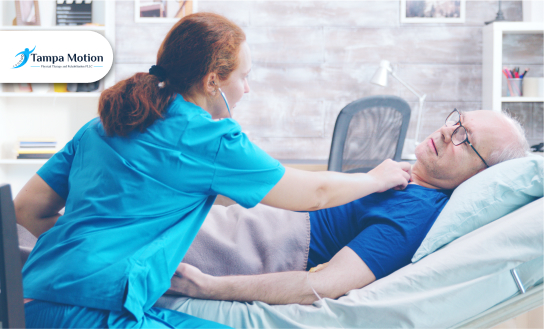
Research suggests that MLD promotes reduction in swelling and inflammation by enhancing lymphatic contractility, rerouting fluid through unobstructed pathways, and supporting the uptake of interstitial fluid without provoking additional irritation.
This gentle encouragement of fluid clearance also supports immune function. It helps lymph nodes filter debris and may mobilize immune cells. In doing so, MLD can aid recovery from surgery or illness.
Behind these results is the expertise of trained practitioners. They study anatomical pathways, knowing exactly where lymph nodes lie. They understand how lymph channels crisscross beneath the skin. With this knowledge, they apply strokes that truly meet physiological intent.
That expertise is validated through certification. Courses such as CMLDT and CLT require 40 to 135 hours of training. They cover lymphatic anatomy, contraindications, hands-on technique, and safety protocols.
This training ensures practitioners deliver MLD with precision, confidence, and clinical integrity as a wellness spa service and also as a therapeutic tool rooted in anatomy and physiology.
Next, we’ll explore precisely who benefits most from this therapy painting the picture of recovery through lymphatic care.
3) Who Really Needs This? (More People Than You Think)
Manual lymphatic drainage serves a wide range of people, each drawn by distinct needs, united by the goal of easing the body’s burden.
Post-Surgery Recovery
For those recovering from surgery, whether cosmetic procedures like facelifts and liposuction or orthopedic operations, MLD offers a way to reduce swelling and speed healing. The therapy gently redirects trapped fluid, softening bruises and helping patients move more comfortably during recovery.
Lymphedema Management
Cancer survivors face unique challenges, especially after lymph node removal. Lymphedema, a painful, persistent swelling, can limit mobility and quality of life. Here, MLD stands as a cornerstone of management, encouraging fluid flow when the body’s natural pathways have been disrupted.
Athletes
Sportspeople turn to MLD as part of their recovery arsenal. After intense training or injury, reducing inflammation and flushing metabolic waste can shave days off healing time, getting them back to peak performance faster.
Chronic Conditions
Long-term conditions such as fibromyalgia, chronic fatigue syndrome, and inflammatory disorders also find relief in MLD’s calming touch. By alleviating fluid buildup and promoting circulation, patients often report reduced pain and greater energy.
Wellness Seekers
Even health enthusiasts who are not managing illness or injury seek MLD for its detoxifying and immune-boosting effects. Regular sessions offer a chance to clear stagnation, refresh the body’s systems, and cultivate a deeper sense of balance.
Next, we will guide you through what to expect during a typical session, demystifying the experience for first-timers and seasoned clients alike.
4) What to Expect During a Session
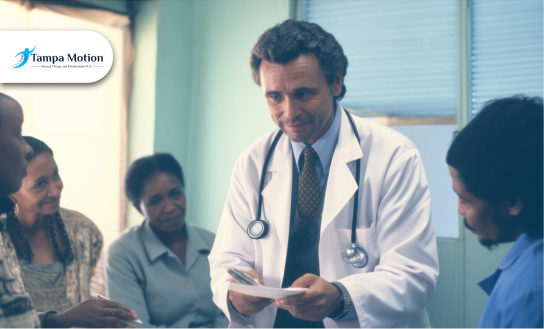
A manual lymphatic drainage session begins with a thorough consultation. The therapist asks about medical history, current concerns, and any areas of swelling or discomfort. This careful intake ensures treatment is tailored and safe.
During the session, clients lie comfortably, often fully clothed or draped with light linens. The therapist uses gentle, deliberate strokes that follow precise lymphatic pathways.
These movements start near major lymph nodes to “clear the way” before addressing affected regions. Sessions typically last between 30 to 60 minutes, depending on individual needs.
Clients often describe the experience as soothing and relaxing, with some noticing immediate relief from heaviness or tension. After treatment, a mild sense of lightness or warmth is common as the body begins to respond.
Safety remains paramount. MLD should be avoided in cases of active infections, blood clots, congestive heart failure, or untreated cancer without medical approval. Practitioners carefully screen for these conditions to protect clients.
Next, we will explore how Tampa Motion brings this specialized therapy to its clients, combining expertise and personalized care for optimal results.
5) How Tampa Motion Does MLD Their Way
Tampa Motion’s manual lymphatic drainage is more than a treatment; it is a carefully built experience designed to support healing and long-term wellness. The clinic combines skilled therapists, integrated therapies, and personalized care to help clients navigate recovery with confidence and comfort.
Expert Therapists: Each therapist holds advanced certification in manual lymphatic drainage with specialized training in post-surgical care and chronic condition support.
Integrated Treatments: MLD is combined with other therapies such as therapeutic massage, physical rehabilitation, and mobility exercises to address swelling, pain, and movement issues comprehensively.
Personalized Care Plans: Every client receives a customized treatment plan tailored to their unique medical history, recovery goals, and lifestyle needs.
Focus on Safety and Results: Tampa Motion prioritizes safe practice and measurable outcomes through ongoing assessment and adjustment of therapies.
Client Partnership: The clinic fosters a collaborative relationship, ensuring clients feel informed, comfortable, and involved throughout their healing journey.
Circulate Toward Better Health with Tampa Motion’s Care Plan
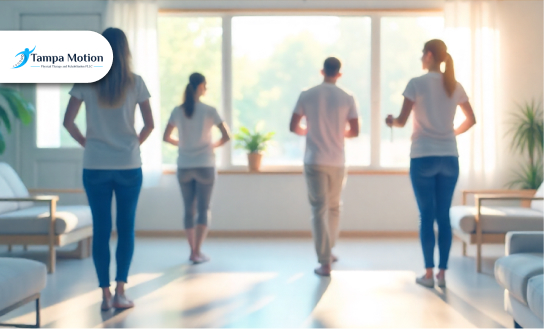
Manual lymphatic drainage may seem gentle, even simple, yet its impact runs deep. By encouraging the body’s own systems to move freely and efficiently, it helps clear blockages that can slow healing and weigh down daily life.
This therapy reaches beyond the immediate goal of recovery. It invites a broader commitment to wellness, a way to nurture the body’s balance and resilience over time.
For anyone facing surgery, chronic conditions, or simply seeking a proactive approach to health, MLD offers a quiet yet powerful support. Tampa Motion welcomes you to experience this therapy firsthand.
Schedule a consultation and discover how gentle touch can open new pathways to lasting well-being.
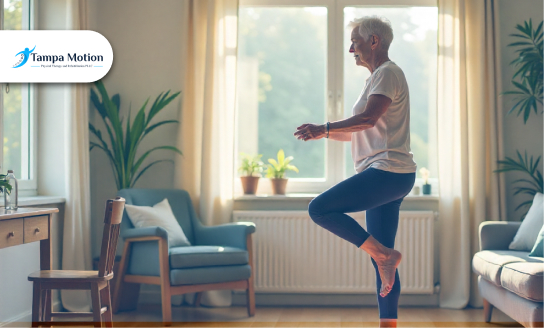
Top Balance Exercises for Seniors at Home
Nobody intends to fall. However, for many seniors, a simple trip or slip can result in much more than just a bruise.
According to the Centers for Disease Control and Prevention, one out of every four adults over 65 falls each year. Falls are not only common; they are the leading cause of injury-related deaths among older adults. Doesn't that sound scary? Good news is you can fight back with something as simple as a few minutes of exercise per day.
If you've been feeling a little unsteady lately or simply want to stay on your feet, this guide is for you. We'll go over a variety of simple, at-home balance exercises that don't require fancy equipment, gym memberships, or a personal trainer shouting in your ear.
1. Safety First: Before You Start
Let's take a quick pause before we begin these exercises. I know you're eager to get moving, which is great; however, your safety always comes first.
If you're dealing with any health issues like heart conditions, joint pain, dizziness, or anything that affects your balance (hello vertigo or neuropathy), it's a smart move to consult with your doctor or physical therapist first. They can assist you in tailoring your routine so that it actually benefits your body rather than straining it.
Now, let’s get your space ready. A few simple changes can significantly improve your confidence (and sense of safety) while exercising.
Supportive Shoes
There are no slippers, flip-flops, or bare feet allowed here. You'll need shoes with a strong grip and adequate ankle support. Consider walking shoes or footwear with a non-slip sole. It helps you stay grounded.
A Stable Chair or Countertop
Whether you're lifting a leg or simply practicing your posture, having something sturdy nearby to hold onto provides balance and peace of mind. Ensure that it does not wiggle or roll.
Clear Floor Space
Remove rugs, cords, and any other items that may interfere with your footing. Even the smallest corner of a mat can be deceptive.
Someone Nearby (Optional yet Helpful)
You do not need someone next to you; however, having a family member, caregiver, or neighbor present, especially the first few times, never hurts. Knowing that someone is present can help to calm nerves and increase confidence.
2. Standing Marches (Great for Beginners)
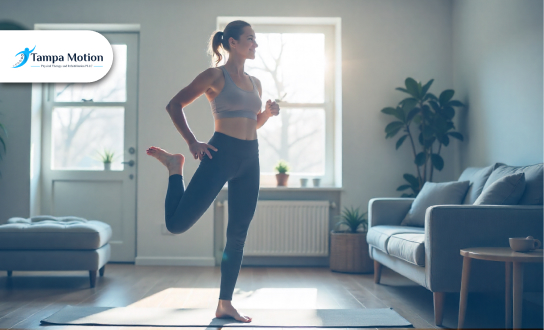
This one is as easy as it sounds and surprisingly effective. Standing marches are a gentle, low-impact way to wake up your muscles and ease into balance exercises, especially if you're just getting started.
How To Do It:
Stand tall behind a strong chair or counter. Rest your hands lightly on it to provide support. Now, lift one knee as if you were marching in place. Lower one knee, then lift the other. Aim to bring each knee up to about hip height, however, don't worry if that feels too much. Even a few inches off the ground is a good starting point.
Why Does It Help:
This movement engages your hip flexors, core muscles, and lower back, all of which contribute to balance and stability. It also improves coordination by allowing your brain and body to fall into a nice rhythm as you move.
According to the National Institute on Aging, exercises like these can improve your walking ability, lower your risk of falling, and even help with everyday tasks like climbing stairs or getting out of the shower.
How Many Repetitions Are There?
Begin with 10 repetitions for each leg. Please take your time; this is not a race. Prioritize control over speed.
3. Heel-to-Toe Walk (Balance + Focus)
This one may bring back childhood memories of walking a line or pretending to be in a circus, however now it's all about improving your balance and coordination.
How To Do It:
Standing tall, walk in a straight line with one foot directly in front of the other. With each step, your heel should come into contact with the toes of your opposite foot, as if you were walking on a tightrope (with significantly less pressure).
Move slowly. Keep your eyes forward, not on your feet. What if you feel unsteady? This is completely normal. Simply pause, restart, and keep going.
Why It Works:
This exercise is excellent for developing balance, focus, and lower body strength, particularly in the small stabilizer muscles around the ankles and knees. It also helps to improve coordination between your eyes, feet, and brain, which is something we all want to maintain as we get older.
The National Institutes of Health (NIH) says that doing exercises that involve both movement and mental focus (like walking and concentrating on form) can reduce fall risk by up to 33%.
Pro Tip: Add a Safety Net
If this is your first time doing it, or if your balance is off, walk along a hallway wall, kitchen counter, or anywhere you can lightly touch something for support. Even having a hand nearby can make a significant difference.
Begin with 5-10 steps, then rest and repeat. The key is to maintain consistency. It's completely fine if you wobble; every step is progress.
4. Single-Leg Stands (One of the Best)
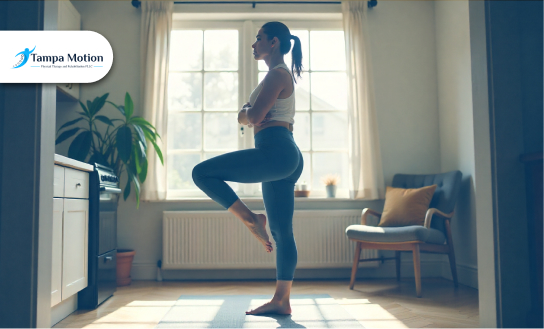
Single-leg stands are one of the most effective balance exercises you can do in under a minute.
How to Do It (Safely & Always):
Stand next to a sturdy counter or chair and gently grab hold for support. Then, raise one leg just a few inches above the ground.
Maintain an upright posture with your standing knee slightly bent (not locked). It is perfectly acceptable to rest your toe on the ground if your balance wobbles at first.
What Is the Goal?
Aim for 10 seconds on each leg, then switch. If that feels good, do it a few times on each side. As you gain confidence, try doing it without your hands or even while brushing your teeth.
Why It Is So Effective:
This simple movement has a significant impact. It strengthens your ankles, hips, and core, all of which contribute to your stability. It also helps your brain communicate more quickly and clearly with your muscles, resulting in faster reflexes and fewer stumbles.
A 2022 study published in the British Journal of Sports Medicine found that adults who could stand on one leg for at least 10 seconds had a significantly lower risk of premature death. 10 seconds of balance could lead to a longer, healthier life.
5. Chair Squats (For Leg Strength & Control)
Strong legs and solid control are essential for moving around your home, using the restroom safely, and getting in and out of bed. Chair squats are one of the most effective ways to build strength.
How to Do It:
Sit in a sturdy chair with your feet flat on the floor, about hip-width apart. Cross your arms over your chest or rest them in your lap, then slowly push through your heels to stand up. Once you are fully upright, slowly lower yourself back down while maintaining control.
Why It Helps:
Chair squats work the thighs, knees, glutes, and hips, basically all of the major muscles that help you walk, stand, and balance. They also improve eccentric control, or your ability to lower yourself without plopping down (which can be harmful to your joints).
According to the National Institute on Aging, exercises that target lower-body strength, such as squats, are critical for maintaining independence and lowering fall risk as we age.
How Many Should I Do?
Start with 2 sets of 10, resting for 30–60 seconds in between. If that feels like too much, start with 5 reps and build up over time.
6. Tai Chi-Inspired Moves (Balance with Grace)
If you've ever seen someone do Tai Chi, you'll notice something right away: it looks almost like dancing in slow motion. However, beneath those gentle movements lies a powerful practice that has helped people, particularly older adults, achieve balance, strength, and peace of mind for centuries.
What It Is:
Tai Chi consists of a series of slow, controlled movements that follow one another. It all comes down to balance, breath, posture, and focus. No jumping or straining, just gentle movement that feels good. Even a few minutes of Tai Chi-inspired moves per day can help:
Coordination
Core strength
Flexibility
Mental clarity
A study in the Journal of the American Geriatrics Society found that Tai Chi can reduce the risk of falls in older adults by 43%. That is nearly reducing your risk simply by moving slowly and deliberately.
Where to Start:
There are many beginner-friendly resources right at your fingertips:
YouTube channels offer free, guided sessions designed specifically for seniors.
Local senior centers and community centers often offer beginner Tai Chi or "movement for balance" classes.
If you're a total beginner, look for short 5–10 minute routines to get started. Even one flow per day is a great start.
7. Seated Exercises (For Days You’re Low on Energy)
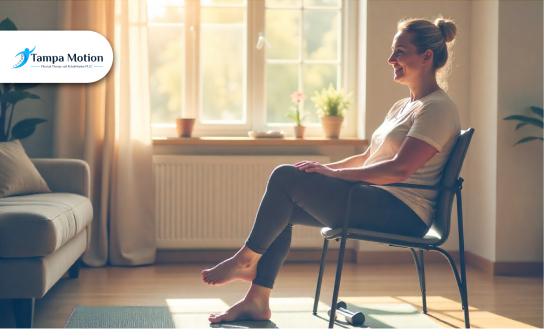
We all have days when we're just not feeling up to standing or moving around much, and that's perfectly fine. Whether you're recovering from an illness, dealing with joint pain, or simply tired, you can move your body in gentle, effective ways.
Movement does not have to involve sweating or standing on one leg. It can be as simple as sitting up straight in a chair and taking a few minutes to stretch and strengthen.
Try These Simple Seated Movements:
Ankle Rolls
Lift one foot off the floor slightly and slowly roll your ankle in circles, 5 in each direction. This keeps the joints mobile and improves circulation.Seated Marches
Sit upright and gently lift one knee at a time, like you’re marching in place. It wakes up your core and hip muscles without putting pressure on your joints.Arm Reaches
Extend your arms up, out to the sides, or across your body. You can even hold a light object (like a water bottle) for added resistance. Great for shoulder mobility and upper body strength.
These exercises are especially helpful for:
Seniors with limited mobility
Those recovering from surgery or illness
Anyone who just needs a gentler movement option that day
Build Better Balance Today with Help from Tampa Motion
We believe that balance is more than just standing tall; it is about living with confidence, security, and ease. Whether you're just starting to feel unsteady or recovering from a fall, our team is here to meet you where you are.
You do not have to go through this journey alone. We provide individualized balance assessments, guided home routines, and one-on-one physical therapy sessions. Our licensed therapists understand the unique needs of older adults and develop care plans that are gentle, practical, and results-driven. Call us or schedule your consultation online with Tampa Motion today.
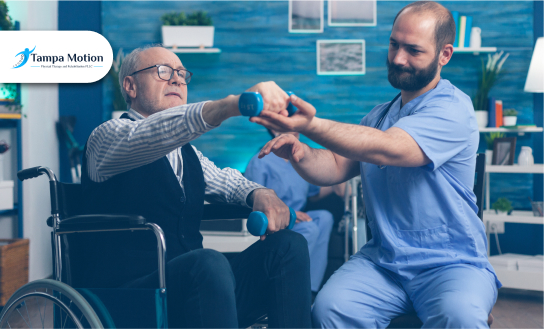
Stroke (CVA) Rehab: What to Expect in Physical Therapy
No one prepares for the silence that follows a stroke. It’s not just the quiet in the hospital room or the lull in conversations. It’s a sudden pause in a life that once moved without thought. One day you're walking to the kitchen. The next, you're relearning how to stand.
Stroke doesn’t ask permission. It interrupts. It changes the very relationship you have with the way you balance, hold a fork, climb stairs, and smile.
However, recovery is a rhythm. A stubborn, hopeful rhythm that begins not in some grand leap however, in the smallest, most unglamorous movements.
And that rhythm? It often begins in a quiet room… with one simple question: “Can you try to move your leg for me?”
1) When Does Physical Therapy Start After a Stroke?
Once a stroke survivor is medically stable, physical therapy often begins within the first 24 to 48 hours. That might sound fast, however, there’s a reason for it. The brain is most responsive to change in those early days. Like a path just cleared after a storm, the brain is actively looking for new ways to reroute what’s been damaged.
Early movement, even just sitting up in bed or shifting weight from one side to the other, sends powerful signals to the brain. It taps into something called neuroplasticity—the brain’s ability to rewire itself, to form new connections when old ones are lost.
And the timing makes a real difference. According to the National Institute of Neurological Disorders and Stroke (NINDS), stroke survivors who start rehab within 7 days see significantly better functional outcomes than those who begin later. It’s not just about speeding up recovery; it’s about improving the quality of it.
Of course, not every patient is ready to jump into therapy immediately, and that’s okay. What matters is recognizing that those first few days are full of potential. And with the right guidance, that potential becomes momentum.
2) What Happens During Stroke Rehab Sessions?
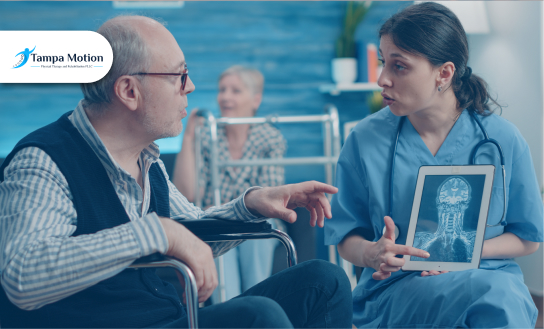
So what does stroke rehab actually look like? It’s definitely not about “pushing through the pain.” Stroke rehab is strategic, structured, and deeply personalized. Every session starts with where you are and builds from there.
Here’s how it typically unfolds:
a) Initial Evaluation & Goal Setting
Before anything else, the physical therapist will assess what’s changed:
Can you move your limbs voluntarily?
Is your balance affected?
How’s your coordination, strength, posture?
From there, they’ll work with you (and your family, if needed) to set realistic, meaningful goals like walking to the mailbox, climbing stairs again, or just getting out of bed without assistance.
b) Gait Training
Walking may seem simple until a stroke interrupts the brain’s communication with the body. Gait training rebuilds that communication. You might start with parallel bars, walkers, or body-weight-supported treadmills. Over time, the focus shifts to improving stride length, symmetry, and foot placement so each step feels safer and stronger.
c) Strength & Endurance Work
Muscle weakness is common after a stroke, especially on one side of the body. Therapists use targeted resistance exercises (think: leg lifts, arm reaches, seated weight work) to rebuild strength without overexertion. Gradually, they’ll add endurance-based tasks like standing for longer periods or walking greater distances to help you function independently.
d) Balance and Coordination Drills
A stroke can throw off your body’s ability to know where it is in space. Balance training comes with activities like
Standing on foam pads
Reaching exercises
Weight-shifting drills
e) Task-Specific Training
This is where things get practical. Think of it as rehab that meets real life:
Climbing stairs
Getting up from a chair
Moving from bed to wheelchair
Practicing bathroom or kitchen tasks
The more relevant the movement, the more the brain connects it to daily living, and that speeds up recovery.
3) What Improvements Can You Expect Over Time?
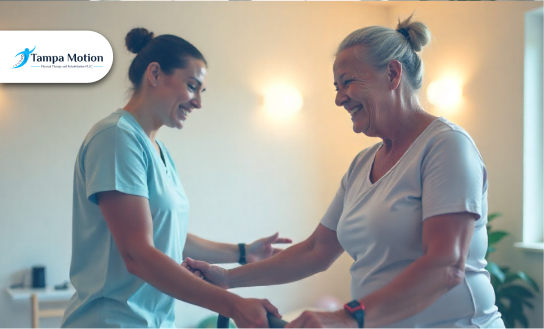
Recovery after a stroke is more like a winding path full of unexpected turns, plateaus, and breakthroughs that sometimes show up quietly. That’s why physical therapists look at stroke rehab for injury rehabilitation in phases, not fixed timelines.
a) The Acute Phase (First Days to 1–2 Weeks)
This is the beginning when the body is still reacting and the brain is just starting to reroute lost signals. The focus here is stabilization, preventing complications, and gently reintroducing movement. Even small shifts, like sitting up or relearning how to swallow, are major steps.
b) The Subacute Phase (2 Weeks to 3–6 Months)
This is where the most visible progress tends to happen. The brain is still highly adaptable during this window, and physical therapy gets more dynamic with walking, transferring, shaping, and task training.
You’ll start noticing things you couldn’t do before slowly becoming possible again. It may be lifting your arm higher, standing up without wobbling, or walking to the bathroom with less help.
c) The Chronic Phase (After 6 Months and Beyond)
By this point, some may assume recovery has peaked however, that’s a myth. While progress might be slower, it absolutely continues. Neuroplasticity doesn’t vanish after 6 months. With consistent rehab, many stroke survivors continue gaining function, mobility, and confidence well beyond that point.
According to the American Stroke Association, 50–70% of stroke survivors regain functional independence with proper rehabilitation. That includes things like walking on your own, dressing, bathing, and cooking again.
4) Every Recovery Looks Different And That’s Completely Normal
There’s no universal timeline for healing after a stroke. Some people regain movement quickly. Others hit walls. There are good days, hard days, and days where nothing seems to move at all.
Frustration is a normal part of the process. So is slow progress. Sometimes, the body is willing however, the mind isn’t. Other times, it’s the opposite. Mentally, you’re ready to move mountains, however, your muscles aren’t following just yet.
And let’s not overlook the emotional and cognitive weight of all this. Many stroke survivors experience:
Fatigue that doesn’t go away with sleep
Memory lapses or slowed thinking
Mood swings, anxiety, or even post-stroke depression
These symptoms can make physical rehab feel ten times harder. That’s why the best rehab plans aren’t just physical; they’re also holistic.
Depending on the needs of each patient, the stroke recovery team may include:
Speech-language pathologists to help with communication or swallowing
Occupational therapists who focus on daily living tasks like grooming, eating, or returning to work
Support groups and mental health professionals for emotional resilience and connection
Your pace is your own. Your story is your own. And that’s expected.
5) Tampa Motion: Stroke Rehab with Compassion, Precision, and Results
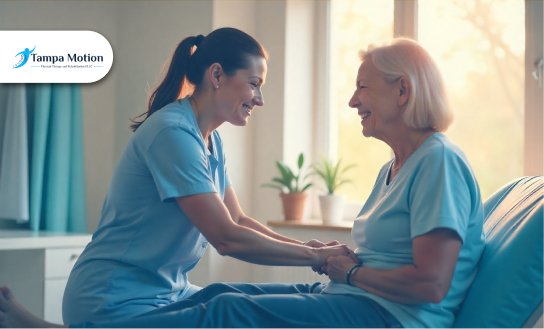
After a stroke, what you need isn’t a checklist of exercises. You need someone who listens when you say, “This feels harder today,” and who quietly adjusts the plan.
That’s what we do at Tampa Motion. We’re not a factory of rehab routines. We’re a clinic built on presence. Our physical therapists are neurologically trained, which means they understand how stroke rewires the brain and how to help you gently and persistently rewrite the story.
We work with you. Not over you. Not around you, with you. You’ll get:
A clear, personalized roadmap for your recovery
Supportive, science-backed exercises you can do at home
One-on-one sessions where your pace is respected, not rushed
Some days, progress is big. Other days, it’s barely visible. We’re here for both.
And if you're ready to take the next step, whether it's standing, walking, or simply believing again, we're ready to meet you right where you are. Have questions about starting stroke rehab in Tampa? We are here for you. Schedule a free consultation today.
6) How to Support a Loved One Going Through Stroke Rehab
Being the person cheering someone on after a stroke is a role that matters more than you might realize. Caregivers also carry hope, patience, and sometimes even the will to keep going.
Here’s how you can make a real difference:
a) Celebrate the Small Wins
Recovery often happens in a finger that moves, a few more seconds standing, a word spoken clearly. These moments might seem small, however, they’re huge. Celebrate them loudly and proudly. It reminds your loved one (and you) that progress is happening, even when it feels slow.
b) Attend Therapy Sessions When You Can
Showing up isn’t just about moral support. It’s about understanding what’s happening in rehab, seeing the exercises, and learning what your loved one is working toward. Plus, it helps you know how to encourage them in just the right ways at home.
c) Ask Tampa Motion How to Help at Home
Our therapists are an excellent resource, so please don't hesitate to ask us what you can do to help progress outside of the clinic. Simple daily routines or gentle reminders can become powerful tools for recovery when you know what to focus on.
Tampa Motion. Recovery that moves with you.
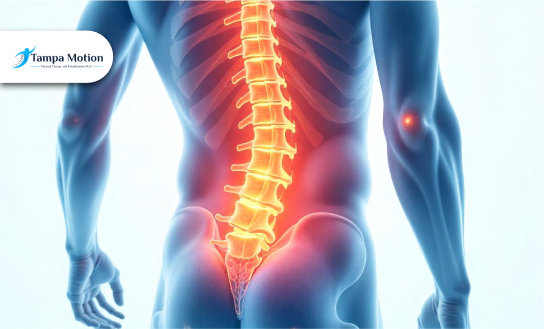
How to Relieve Lower Back Pain Without Surgery
Lower back pain is terrible. It can creep in after a long day at work, as a strange twist while picking something up, or simply because you dared to exist after 30. If you are dealing with it, you are not alone. Approximately 80% of adults will experience lower back pain at some point in their lives.
The good news? The majority of back pain can be treated without surgery. Yes, you read that right. You don't have to rush into scary procedures or rely on pain medications indefinitely. With the right habits and some smart, natural approaches, you can begin to feel better and possibly move like your spine is not 100 years old.
Step 1. Understand What’s Really Going On With Your Back
Back pain can feel like it came out of nowhere. One day you're fine, and the next you're walking like you're 60 years old. However, most of the time, there is a reason hiding in plain sight.
It could be poor posture (yes, slouching counts), muscle strain from twisting the wrong way, or simply too much sitting from desk jobs, binge-watching marathons, and long commutes.
“Sedentary behavior is linked to increased low back pain, especially in adults aged 20–64.”
Source — National Institutes of Health
Then there's your spine. Herniated discs and degenerative disc issues can develop as we age, particularly if your body has been neglected over time.
Your lower back is just responding to how you treat it. The key is to figure out why you're in pain so you can treat it properly rather than hoping it goes away.
Step 2. Move Gently Because Your Muscles Are Stiff, Not Broken
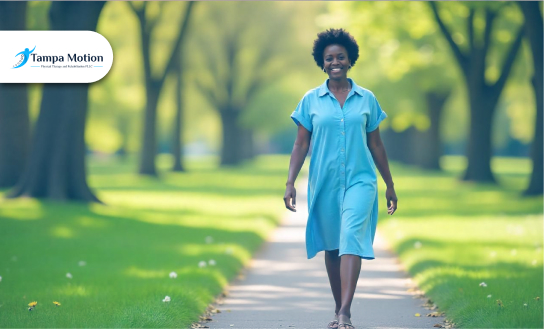
When your lower back hurts, it's tempting to freeze like a statue and avoid all movement. Pain is a completely understandable signal to your brain to stop everything. However, remaining motionless for too long exacerbates the situation.
Your back muscles are undamaged. They may be stiff, overworked, or underutilized, but they are still on your team. They require gentle, low-impact movement to wake up, stretch, and heal.
"Exercise therapy reduces the risk of recurrent lower back pain by 25-40%."
Source — Cochrane Review
Start with something simple and non-threatening:
Walking: Even a leisurely stroll counts. It increases blood flow, keeps your joints healthy, and promotes good posture.
Yoga: It involves purposeful stretching. It's ideal for relaxing tight muscles and calming the nervous system.
Swimming: The water supports your body weight, allowing you to move freely without causing spinal strain.
You don't have to become an athlete overnight; simply get into the habit of moving around every day.
Step 3. Stretch to Strengthen Your Core
Stretching isn't just for gym classes or yoga influencers; it's one of the simplest and most effective ways to keep your lower back from protesting again.
When your hips or hamstrings become tight, they pull on your lower back. And that tension settles in and becomes comfortable unless you tell it to leave. Stretching on a daily basis can help with that.
Here are a few that don’t require fancy gear or a personal trainer:
Child’s Pose
A gentle stretch that elongates your spine and releases tension. It’s like giving your lower back a deep sigh of relief.Cat-Cow Stretch
This one’s great for mobility. It gets your spine moving smoothly and helps ease stiffness around the lower back and neck.Hamstring Stretch
Tight hamstrings are sneaky troublemakers. Stretching them can reduce the strain on your lower back, especially if you sit a lot.
“Regular stretching improves flexibility and reduces pain in patients with chronic low back pain.”
Source — Journal of Orthopaedic & Sports Physical Therapy
Now let’s talk about strength. You don’t need to hit the gym or aim for abs of steel; just build some stability around your spine. A stronger core means less strain on your lower back during everyday stuff like standing, bending, or sneezing too aggressively (we’ve all been there).
Start simple with:
Glute bridges great for core and lower back support
Bird-Dog improves coordination and balance
Side planks target those deep stabilizing muscles (without much movement)
Stretching unlocks tight muscles, and strengthening gives your back the backup it needs to stay pain-free. Do both consistently, and your spine might just throw you a thank-you party.
Step 4. Fix Your Work Setup
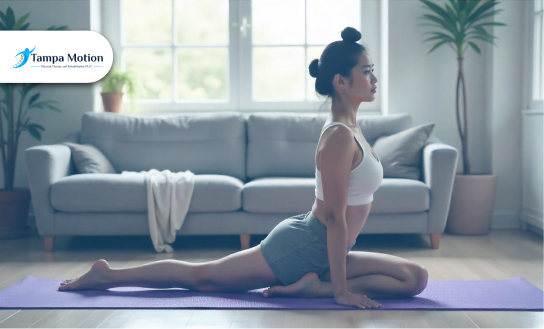
If your lower back begins to ache halfway through the day, your desk setup may be silently troubling you. Most of us weren't taught anything about ergonomics; we just sat down and hoped for the best.
However, if your chair, desk, and screen do not work in tandem with your body, your spine suffers. Let’s break it down simply:
Lumbar Support: Your lower back is naturally curved, and your chair should support it rather than flatten it. If your current seat does not provide that, try a small pillow or lumbar cushion.
Feet Flat on the Floor: Dangling feet or legs scrunched under you mess with your posture. Keep your feet grounded, knees at hip level, and avoid sitting cross-legged for hours.
Monitor at Eye Level: Tilting your neck down or squinting at a screen that is too far away strains your back as well. Raise your screen to eye level; books or a cheap laptop stand can do the trick.
“Proper ergonomic adjustments can reduce musculoskeletal pain by 61% in office workers.”
Source — Applied Ergonomics Journal
Small changes can provide significant relief. You don't need to buy an expensive setup; simply make your space work for you rather than against you.
Step 5. Heat or Ice? Pay Attention to What Your Back Is Requesting
When your lower back hurts, one of the first things you think about is whether to use an ice pack or a heating pad. The answer varies depending on the type of pain you are experiencing. Here's your cheat sheet:
Use ice when the pain is new; think swelling, inflammation, or a recent strain. Ice calms things down, reduces puffiness, and helps numb that sharp discomfort. Stick to 15–20 minute sessions in the first 48 hours.
Use heat when your back just feels tight, stiff, or achy like it’s been nagging you for a few days (or weeks). Heat increases blood flow and helps those tight muscles let go of all that tension they’ve been hoarding.
The trick is to avoid doing too much of either. If you are unsure, alternate, and always wrap the heat or ice with no direct skin contact, unless you are attempting to trade back pain for a burn (please do not).
Step 6. Consider Physical Therapy
Most people believe that physical therapy is something you do after surgery or a major accident. However, you do not have to be recovering from a major injury to benefit from PT.
If your lower back pain persists or refuses to go away, a physical therapist can assist you in determining the underlying cause rather than simply treating the symptoms.
They will examine how you move, sit, bend, and even walk. Then they'll create a customized plan for you, including exercises and techniques to improve flexibility, posture, strength, and alignment.
It is both noninvasive and drug-free. There are no dangerous machines or mention of surgery. Only expert guidance and hands-on help to train your body out of pain.
“Physical therapy is 2x more effective than standard care for chronic low back pain.”
Source — Journal of the American Medical Association (JAMA)
And don’t worry, you won’t be thrown into intense workouts on Day 1. PT is slow, steady, and focused on healing. It is one of the smartest long-term investments you can make for your back.
Step 7. Calm Your Mind, Rest Your Body
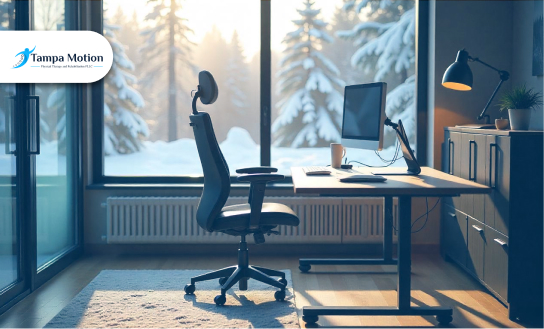
Stress has a sneaky way of settling into your body. When you’re anxious or overwhelmed, your muscles tense up (especially around your neck, shoulders, and lower back). And if that tension sticks around, your pain can become a loop: stress causes pain → pain causes more stress → and round we go.
Breaking that loop doesn’t mean you need a spa weekend (though, hey, not a bad idea). Small daily habits make a huge difference:
Mindfulness or guided breathing for 5 minutes a day
Journaling to offload mental clutter
Even just stepping outside and taking a proper breath
Now, let’s discuss sleep. If you keep tossing and turning all night, your back will not get the rest it requires to heal. Poor sleep not only makes you tired, but it also increases your pain sensitivity, exacerbates inflammation, and slows healing.
“People with insomnia are 3–4x more likely to develop chronic pain.”
Source — Sleep Foundation
How to Sleep Smarter:
Try sleeping on your side with a pillow between your knees
To relieve pressure while sleeping on your back, place a pillow under your knees.
Purchase a supportive mattress topper or even a firm pillow; your spine will notice.
So, while stress management and getting enough sleep may appear to be simple tasks, they are extremely effective. Your nervous system and spine are in constant communication. Give them both the support they deserve, and you will notice a difference.
You Deserve Relief, and Help is Closer Than You Think
Lower back pain does not need to be your "new normal." Whether it came on gradually or suddenly, there are real, practical ways to start feeling better without surgery. Your body desires to heal through gentle movement and better sleep, as well as stress relief and posture correction. You simply need to provide it with the necessary tools and, in some cases, the appropriate team.
Tampa Motion Therapy approaches pain treatment in a smart, personalized manner; there are no cookie-cutter plans, and appointments are not rushed. Just real professionals who will listen, guide, and assist you in returning to your desired way of life.
So, if your lower back has been running the show lately, it may be time to take back control. Contact us at +1 813-291-3536 or schedule an appointment through our website.
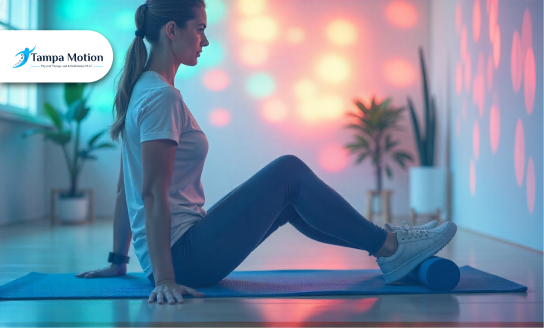
Best PT Exercises for Knee Pain Relief
Tired of wincing every time you stand up, sit down, or walk down the stairs? You are not imagining how common and frustrating knee pain is. It disrupts your day in the most infuriating ways, whether it appeared out of nowhere or crept in gradually.
According to the CDC, one in every four adults experiences chronic knee pain. And, while it can be discouraging, there is genuine hope without resorting to surgery or shots. Physical therapy exercises can help you gain control. They're simple, low-impact, and surprisingly effective when done consistently. No gym. No weights. All you need is your body and some patience.
Let's look at the best physical therapy exercises that can actually provide relief, and no, none of them require a superhero's pain tolerance.
Why Physical Therapy Is More Than Just Exercise
When people hear the term "physical therapy," they often envision endless squats or someone pushing their leg until they cry. No, that is not it. Physical therapy is more than just random exercise; it is a personalized, science-backed plan to help your body move better and hurt less.
What distinguishes PT from other therapies? It has a specific target. A licensed physical therapist observes your movements, identifies the muscles that require support, and develops a plan specifically for you. These are not generic stretches; they are rehab moves that will help you regain strength, reduce joint strain, and move with confidence again.
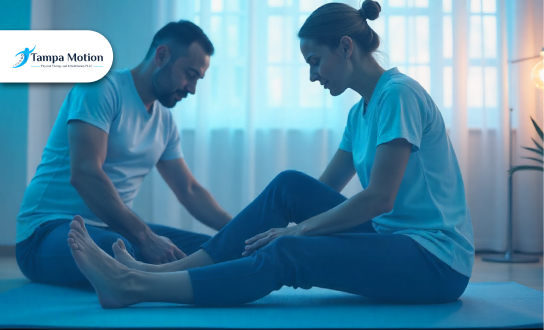
“Patients with knee osteoarthritis who completed a structured PT program were 66% less likely to need knee surgery.”
Source – New England Journal of Medicine
Compare this to surgery, which is costly, risky, and requires months of recovery. Then there's medication, which provides temporary relief however, does not address the underlying issue and frequently causes side effects.
The 7 Best PT Exercises Backed by Science
Physical therapists use these exercises on a daily basis. They are gentle, effective, and, most importantly, proven to alleviate knee pain. You won't need any special equipment; just some space, a mat or towel, and some consistency.
1. Quad Sets
Targets: Front thigh muscles (quadriceps)
Why it helps: Strengthens the quads without bending the knee—perfect if your joint feels stiff or inflamed.
How to do it:
Sit or lie down with your leg straight
Tighten the muscles on the front of your thigh
Hold for 5–10 seconds, then release
Do 2 sets of 10–15 reps
2. Straight Leg Raises
Targets: Quads, hip flexors
Why it helps: Builds strength in the muscles that stabilize your knee—especially useful after injury or surgery.
How to do it:
Lie on your back, one leg bent, the other straight
Tighten your quad and slowly lift the straight leg 12 inches
Hold for 2–3 seconds, then lower slowly
Do 2 sets of 10–15 reps per leg
3. Heel Slides
Targets: Knee joint mobility, hamstrings
Why it helps: Helps restore your knee’s ability to bend and straighten without forcing it.
How to do it:
Lie on your back with legs straight
Slowly slide your heel toward your butt, bending the knee
Stop when it feels tight—not painful
Slide back out
Do 2 sets of 10 reps
4. Hamstring Curls (Standing or Lying Down)
Targets: Hamstrings (back of the thigh)
Why it helps: Balances out the quads and reduces pressure on the kneecap.
How to do it (standing):
Stand tall, hold onto a chair or counter
Bend one knee, bringing your heel toward your butt
Hold for 3 seconds, then lower
Do 2 sets of 10–15 reps per leg
5. Step-Ups
Targets: Quads, glutes, and calves
Why it helps: Mimics everyday movements like stairs—great for real-world strength and control.
How to do it:
Use a low step or sturdy platform (4–6 inches)
Step up with one leg, then the other
Step down slowly
Keep your knee aligned, not caving inward
Do 2 sets of 10 reps per leg
6. Wall Sits
Targets: Quads, glutes, core
Why it helps: Builds endurance and joint support without dynamic movement.
How to do it:
Stand against a wall, slide down until knees are slightly bent
Hold for 10–30 seconds (start small)
Rest and repeat for 3–5 reps
7. Calf Raises
Targets: Calves and ankle stability
Why it helps: Strong calves help stabilize the entire leg chain—yes, even the knee.
How to do it:
Stand tall, feet hip-width apart
Raise heels off the ground, hold at the top
Lower slowly
Do 2 sets of 10–15 reps
These aren’t quick fixes, yet they are powerful tools. When done consistently, they retrain your body to move better, reduce inflammation, and make your knees feel stronger and more stable each day.
How Often Should You Do These Exercises?
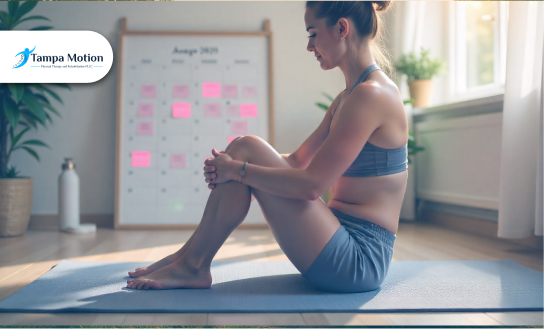
To get real relief, you do not need to work out like an athlete. In fact, doing too much too soon can be counterproductive. A steady, manageable routine is ideal
Physical therapists recommend that most people perform these exercises three to five days a week, with two to three sets of each. That is all. You are aiming for consistency rather than exhaustion.
“A 2022 meta-analysis found that exercising 3 times per week significantly reduced knee pain and improved function in patients with osteoarthritis.”
Source – Arthritis Research & Therapy
If your knees are sore or swollen, reduce your activity. Perform fewer reps. Take a day off. What matters most is that you show up again tomorrow rather than pushing through the pain today.
Consider brushing your teeth, quick, daily care goes a long way compared to the occasional deep scrub. The goal is to gradually build strength and stability rather than burn out in a week.
When to Stop and When to Call Tampa Motion
Pain does not always equal gain. Some discomfort is expected when retraining muscles, however, there is a limit. And your knee will notify you when you've crossed it. Here are some red flags that you shouldn't overlook:
Swelling that persists
Sharp or stabbing pain.
A knee that feels like it will give out
Crunching, locking, or unexpected stiffness
If you've been doing the right exercises for 2 to 3 weeks and your knee still hurts (or worsens), that's a sign. It's time to speak with someone who has a broad perspective.
“Only 30% of people with knee pain seek professional treatment in the early stages—missing the window for conservative care.”
Source – Journal of Orthopaedic Research
And that early window? It matters. Physical therapy is most effective when started before the pain becomes chronic. The sooner you receive personalized care, the quicker (and easier) your recovery.
So, if you don't see any progress, don't wait. Reach out to Tampa Motion. They are movement specialists, not pain pushers. Their job is to assist you in healing smarter, not tougher.
Relief Is Possible, You Just Need the Right Plan
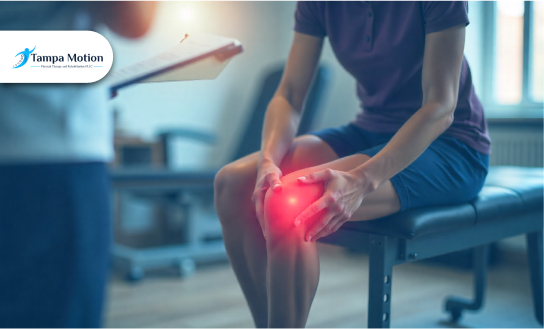
If your knee pain is interfering with your life due to arthritis, an old injury, weekend sports, or simply wear and tear, there is hope. Physical therapy can be customized to address your specific pain, body, and lifestyle. There are no one-size-fits-all strategies here.
Whether your knees ache while climbing stairs or flare up after a jog, the right movements, done correctly, can restore strength, reduce inflammation, and restore confidence in your steps.
The Tampa Motion team understands this. They do not only treat knees; they also treat people. They will work with you one-on-one to develop a recovery plan that is tailored to your needs, not those of others.
Book a no-obligation physical therapy consultation and take the first step toward pain-free movement.

